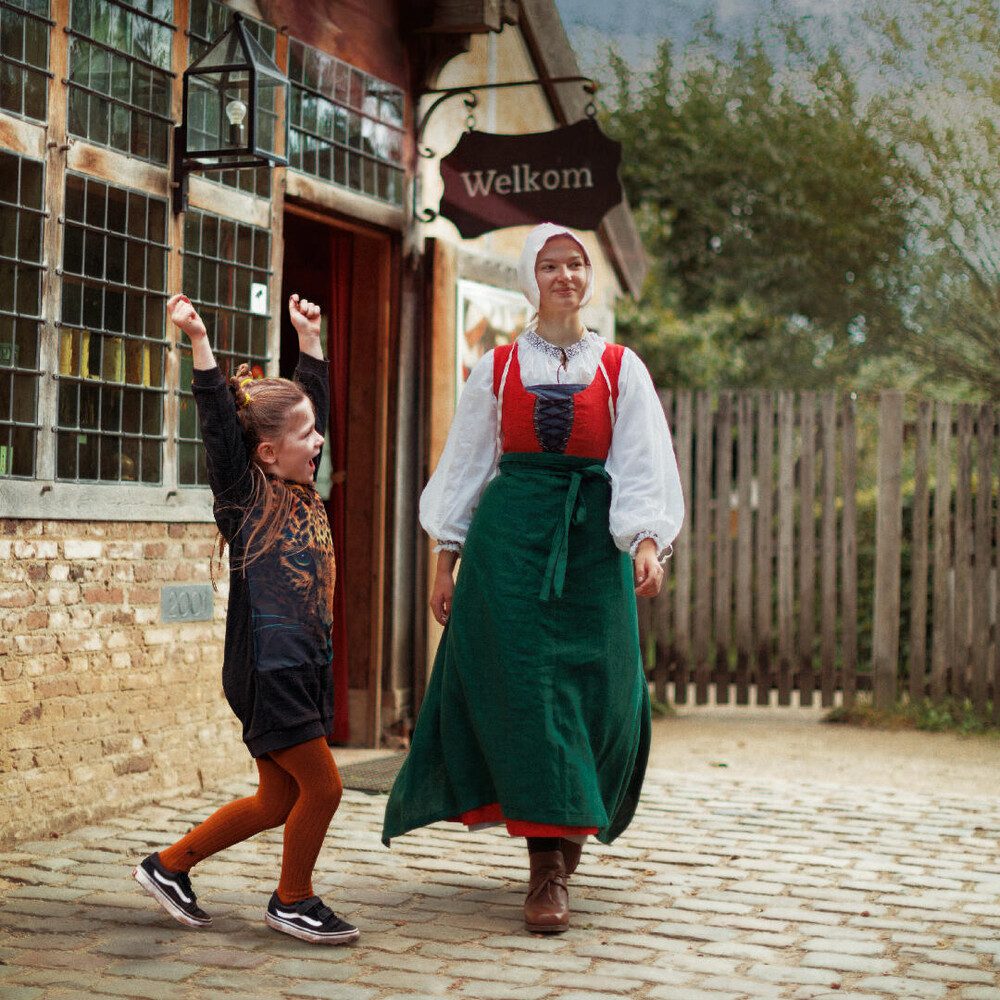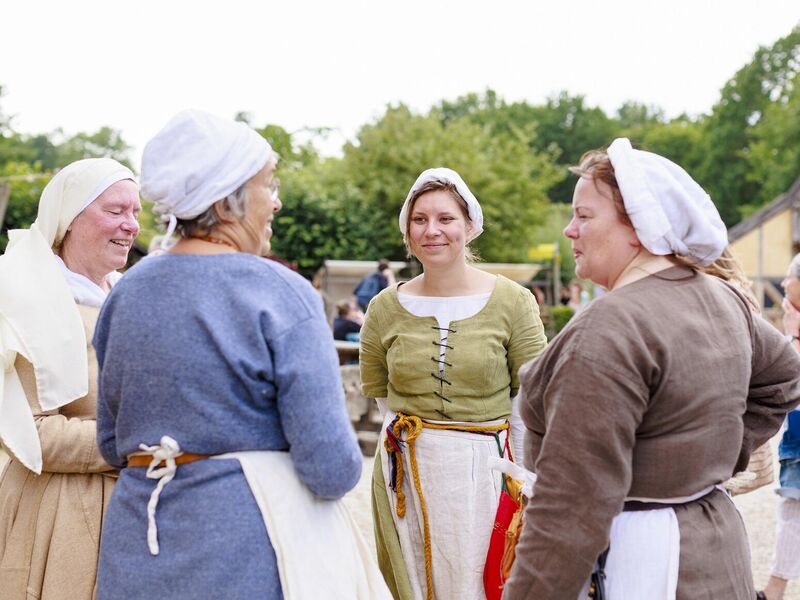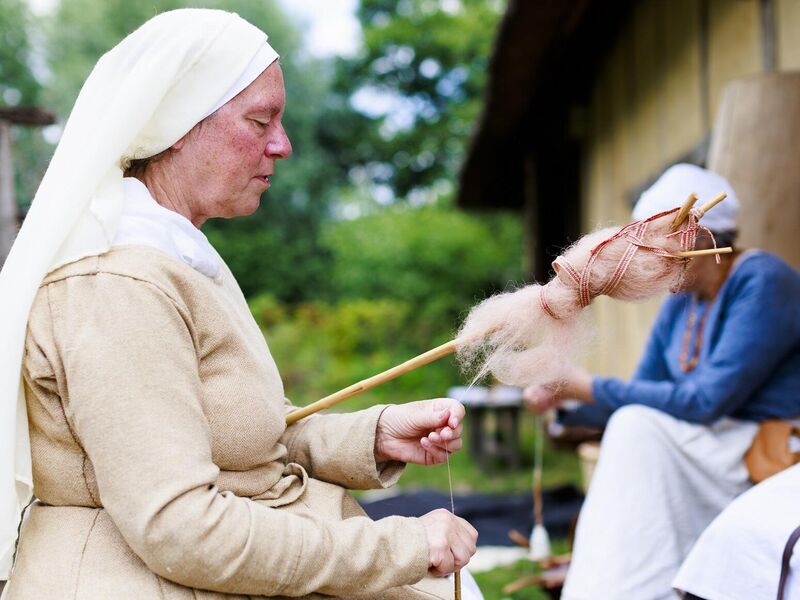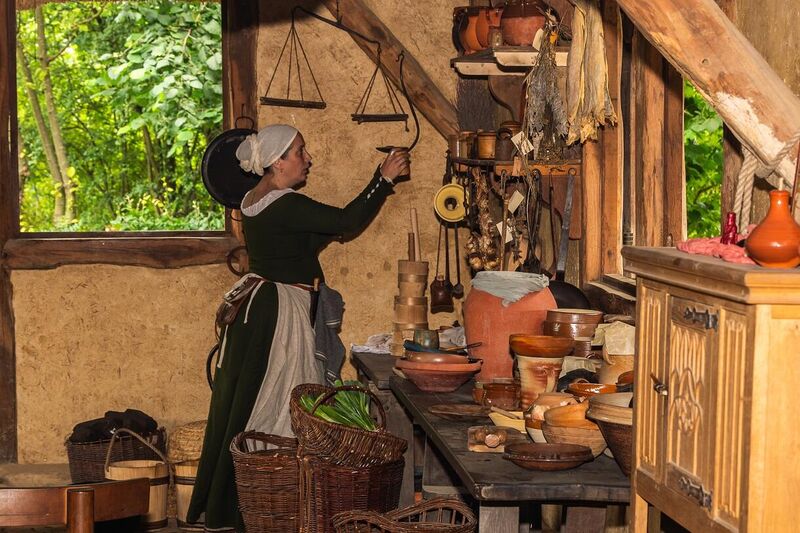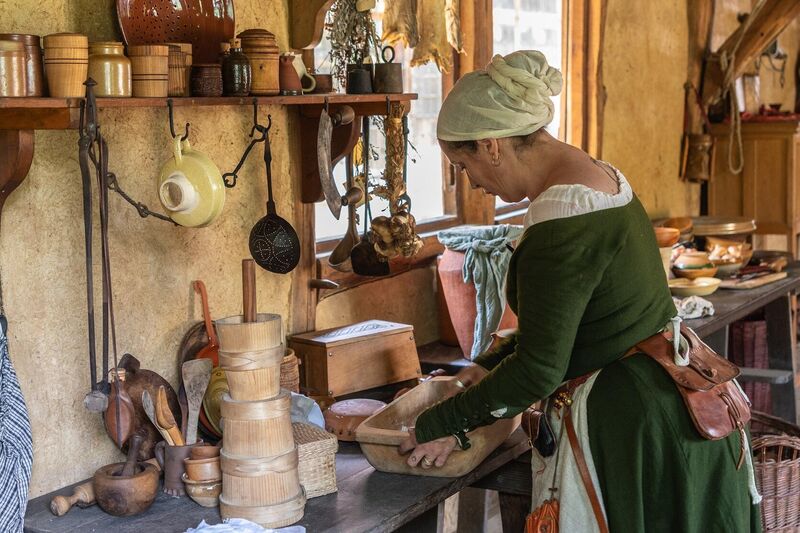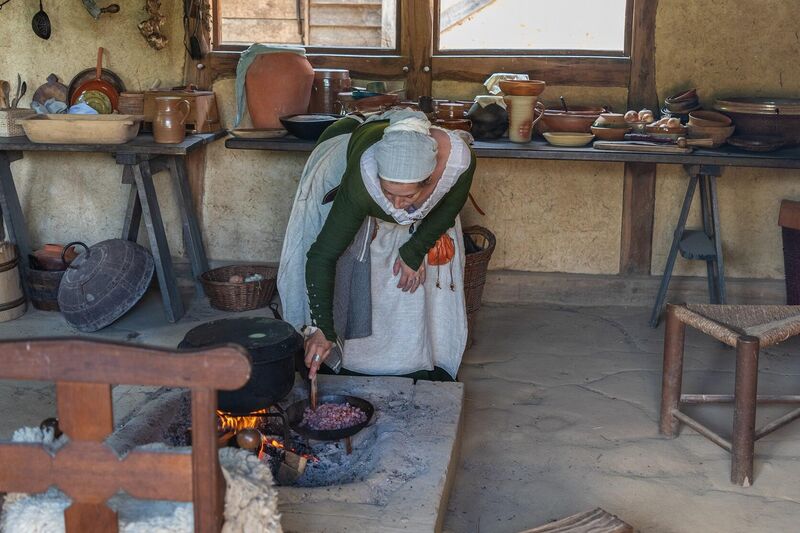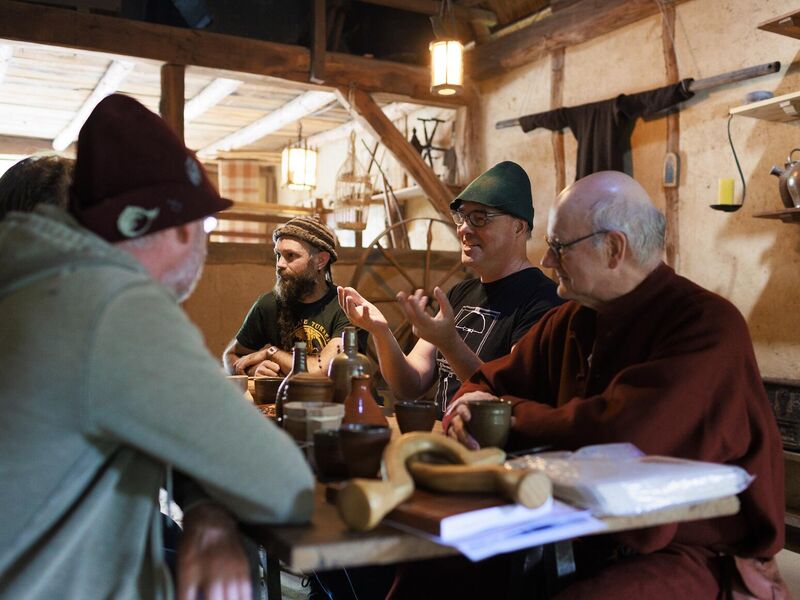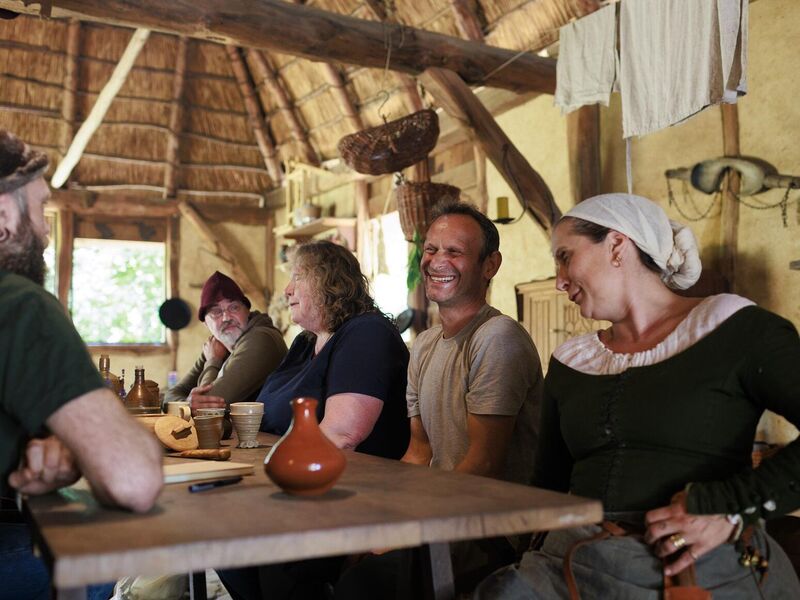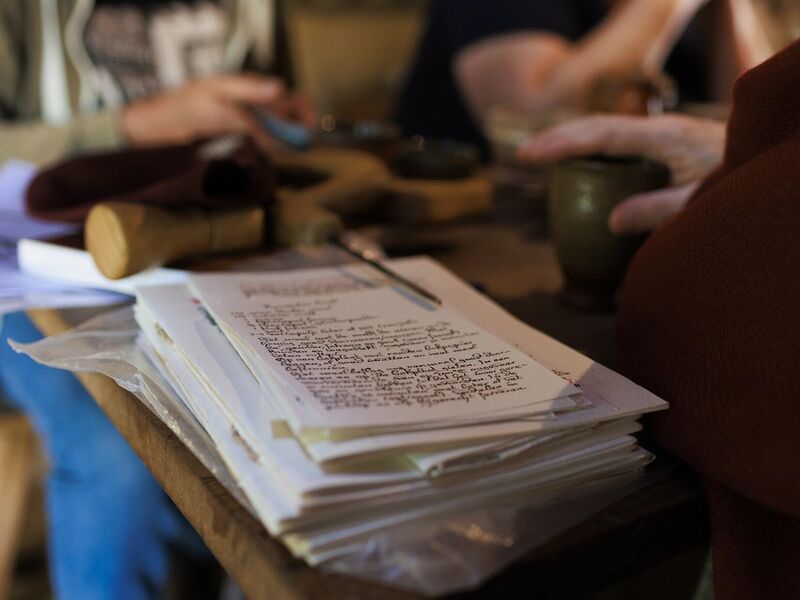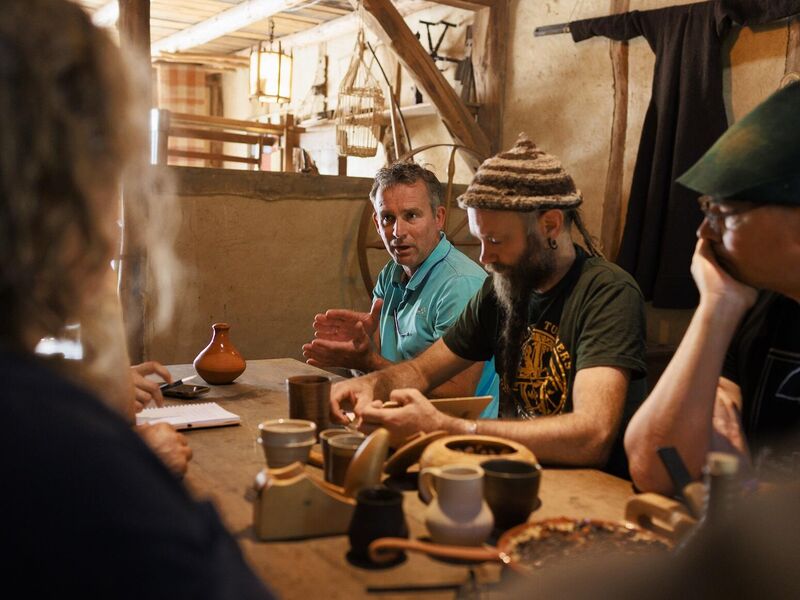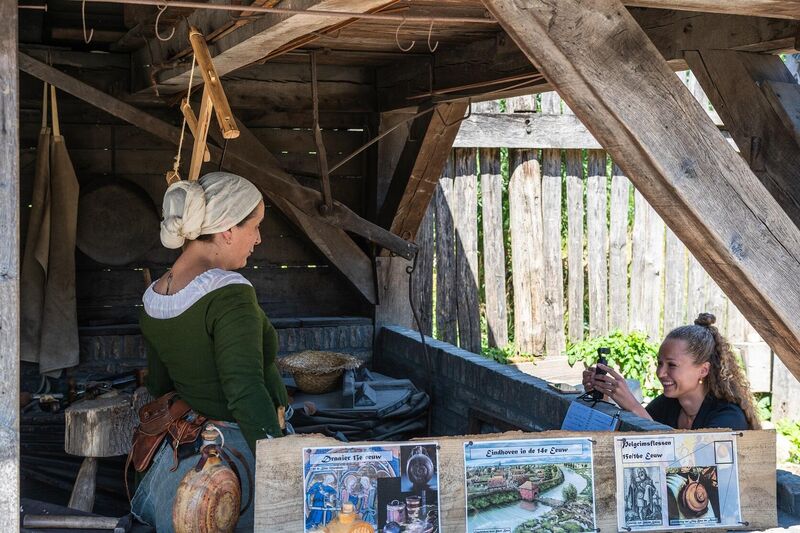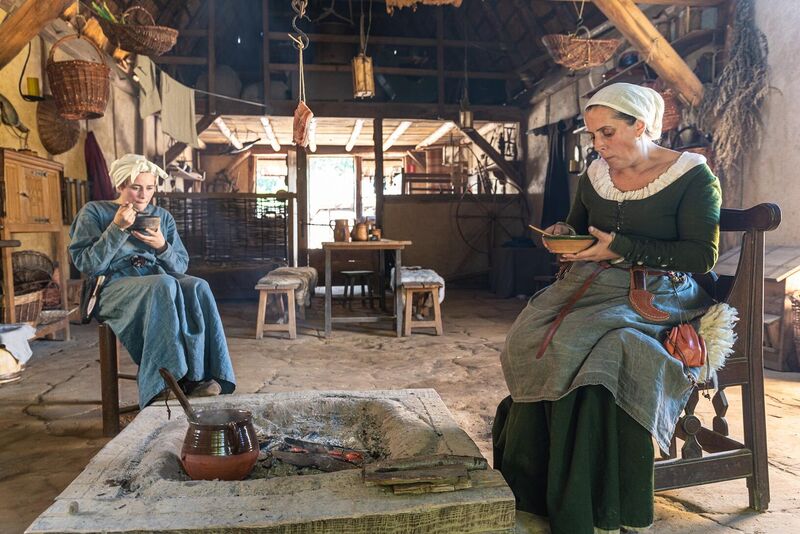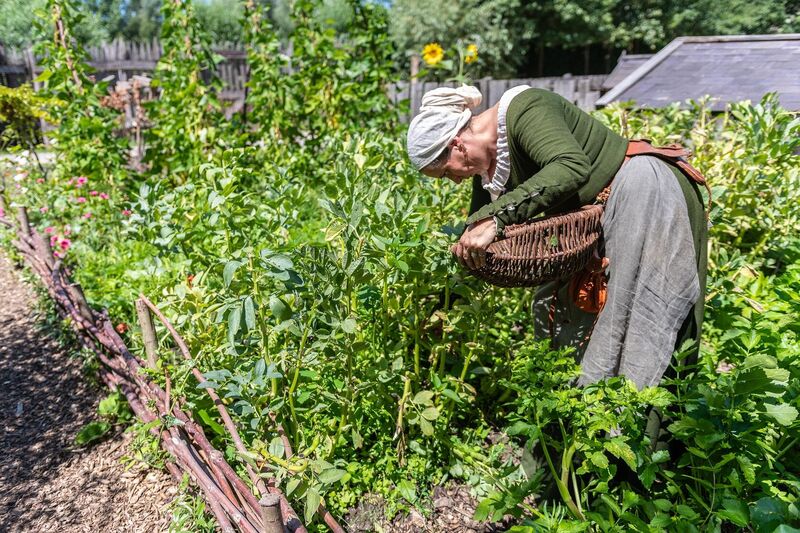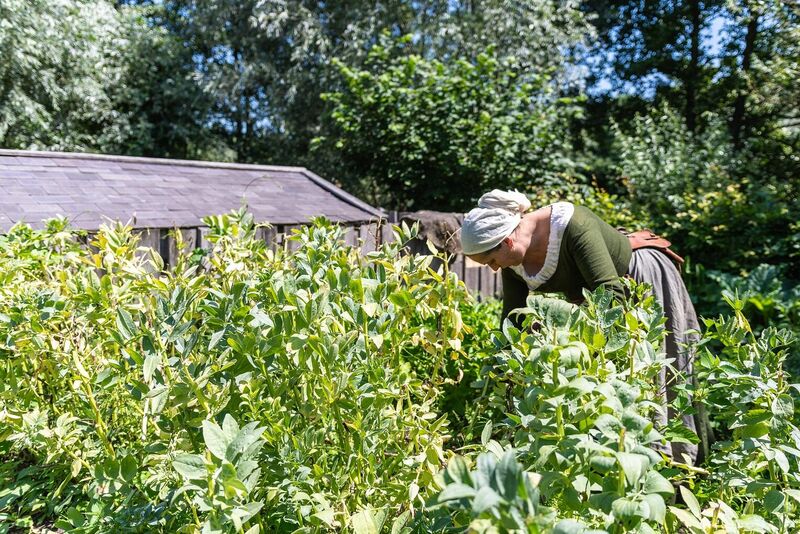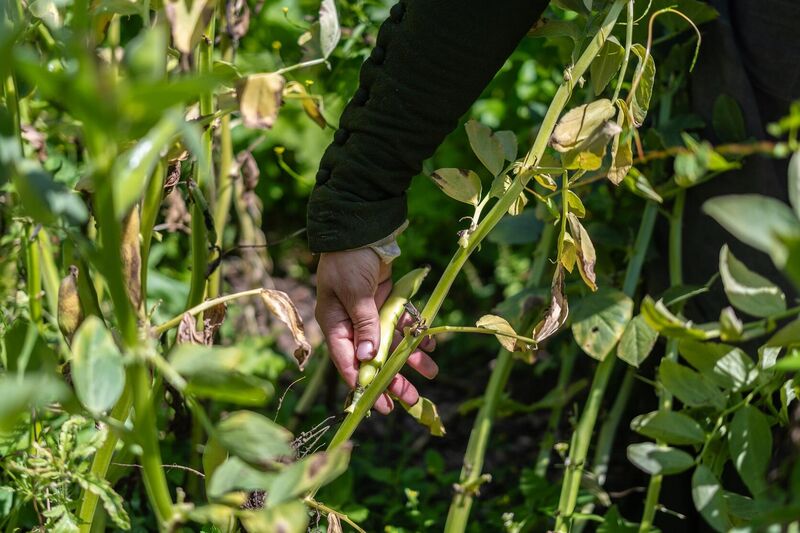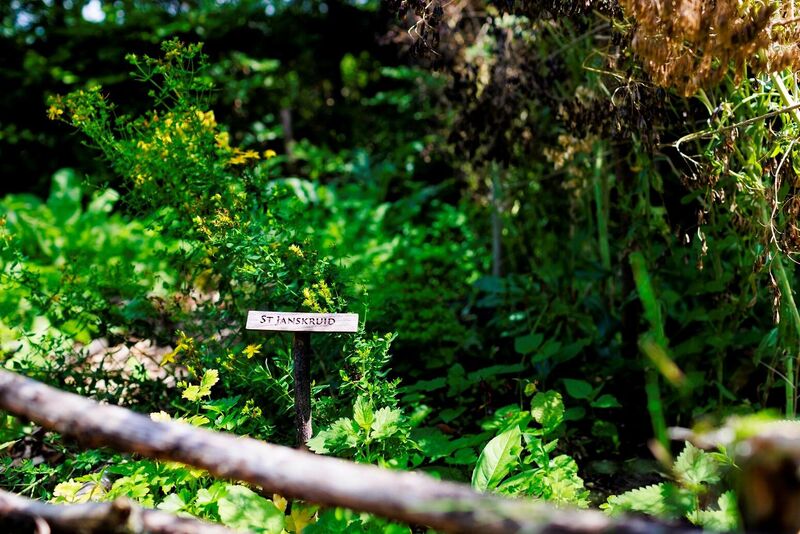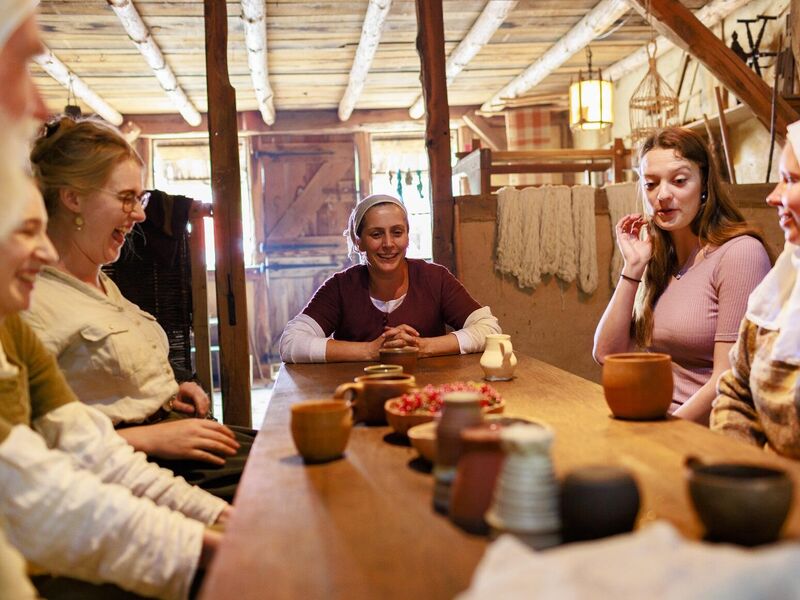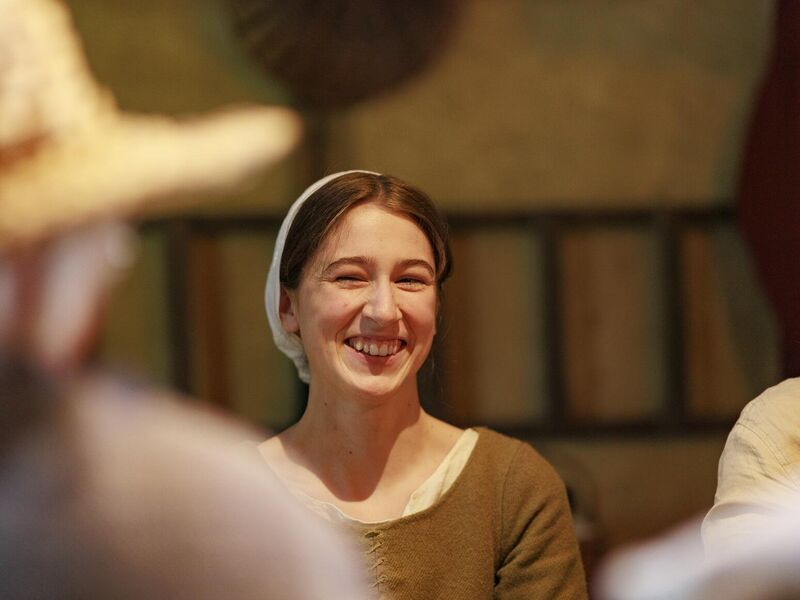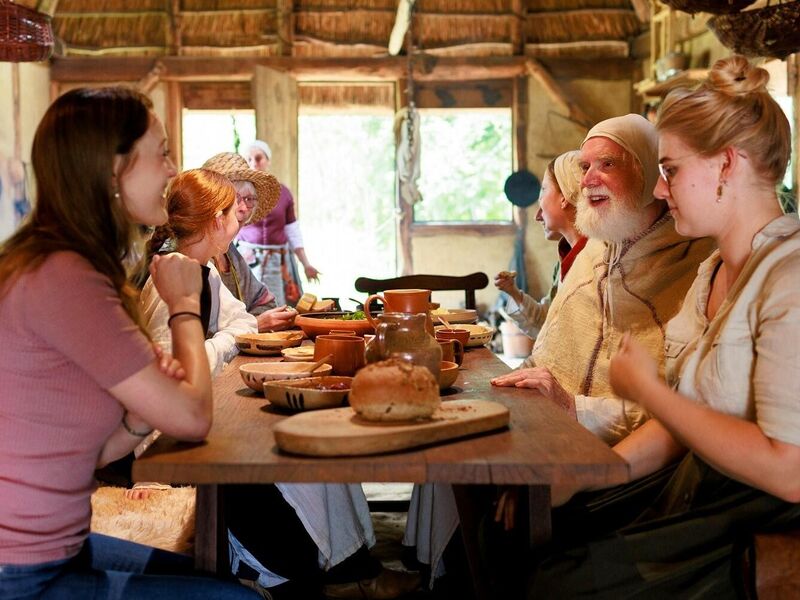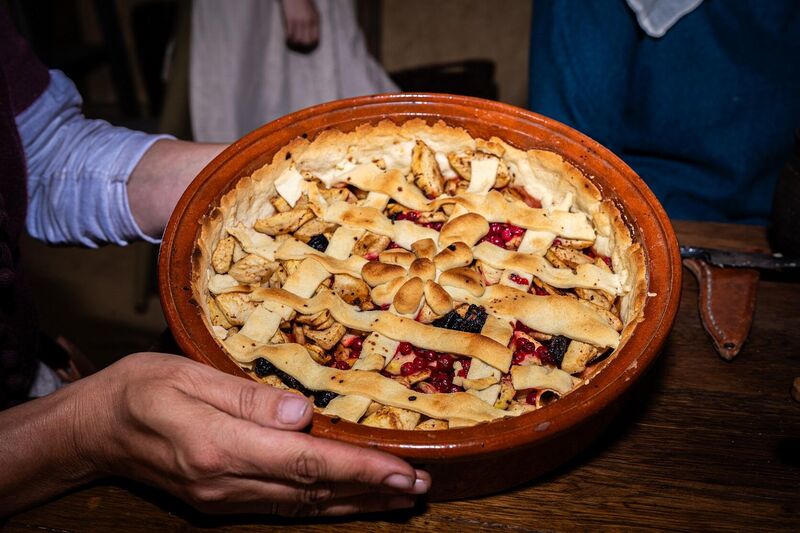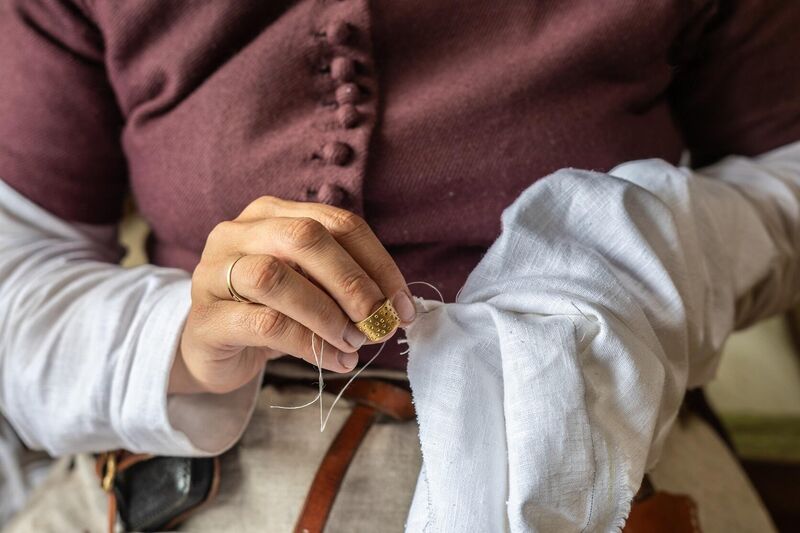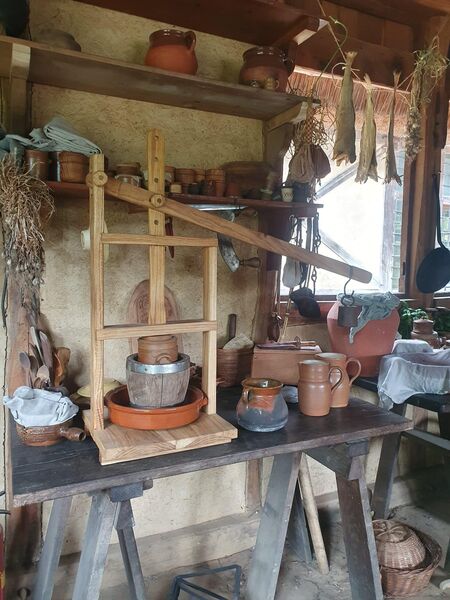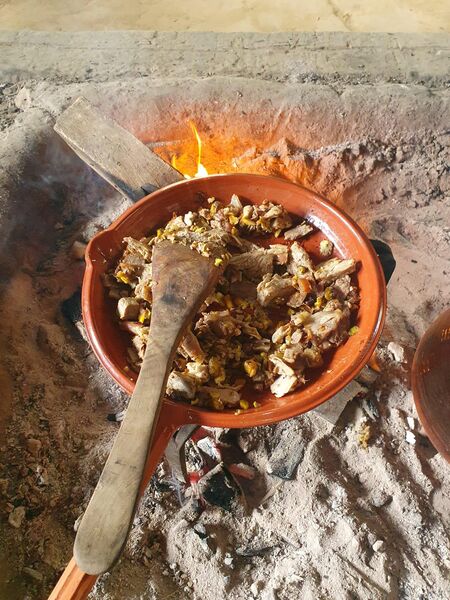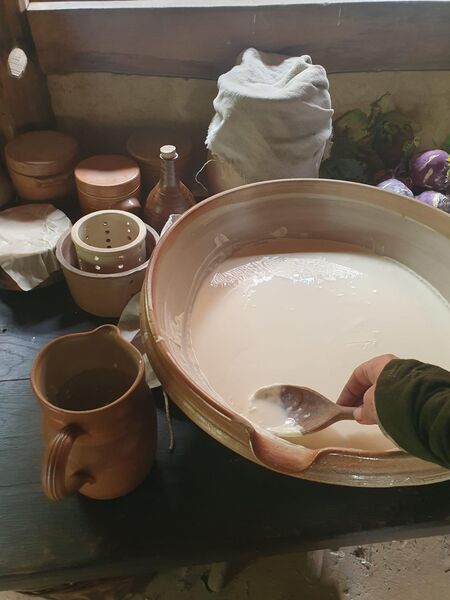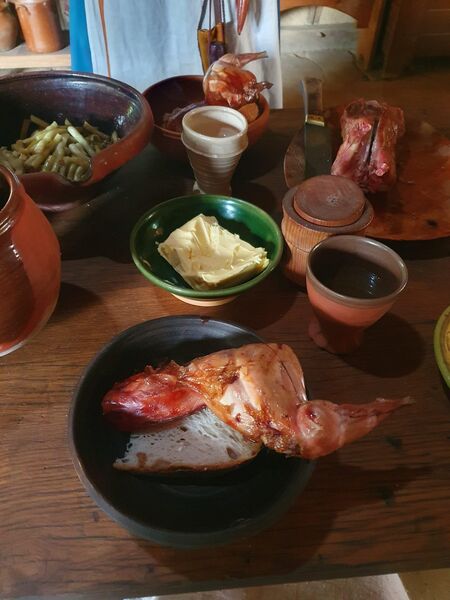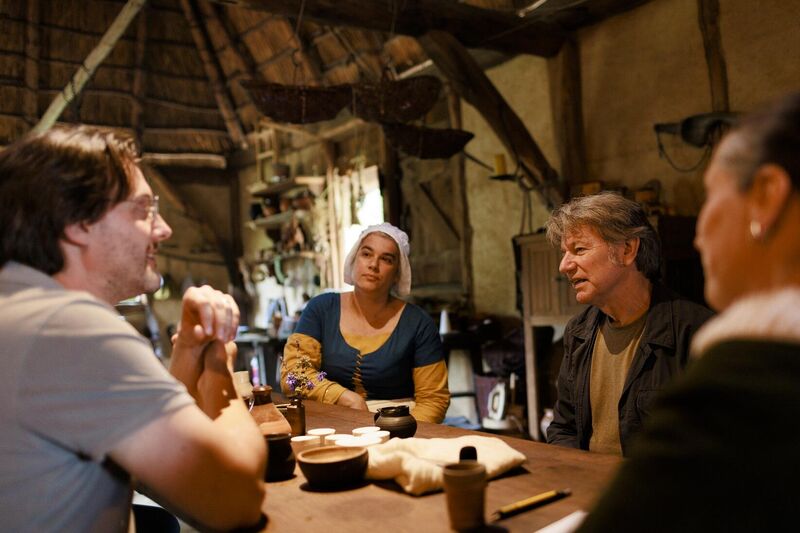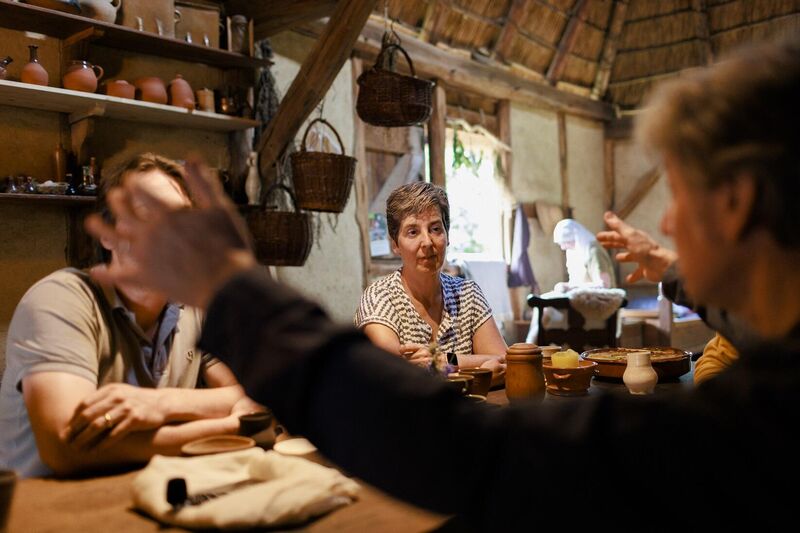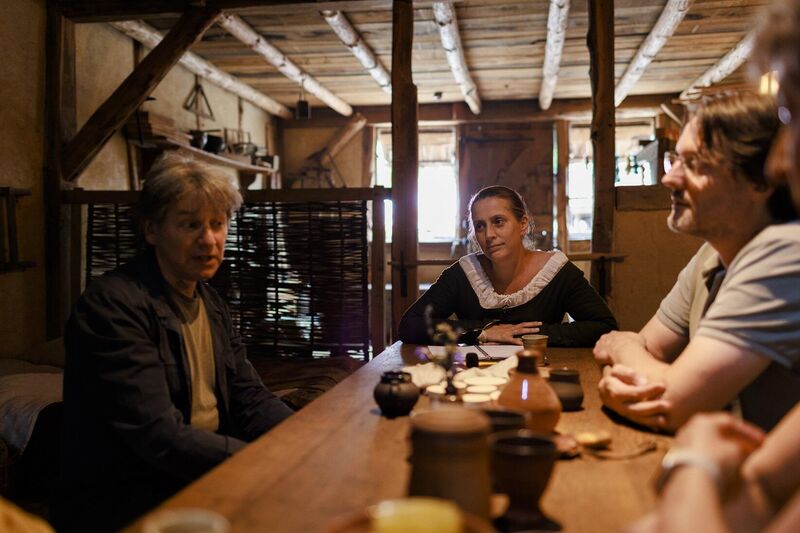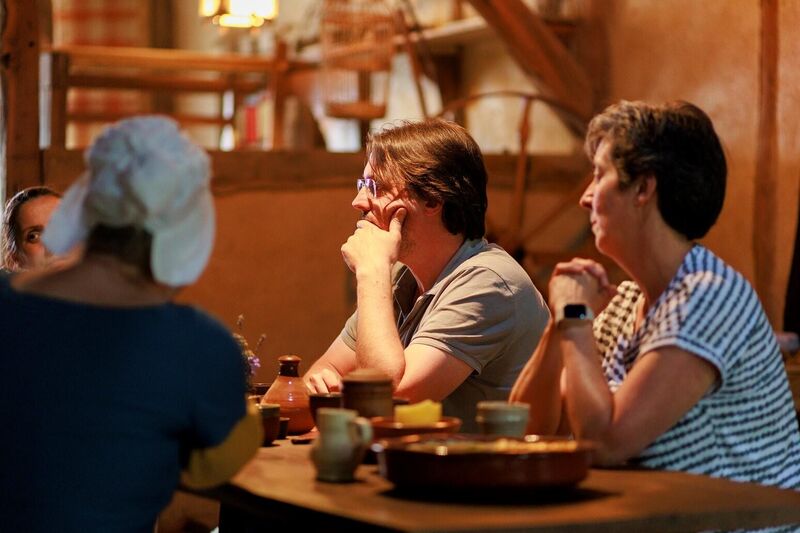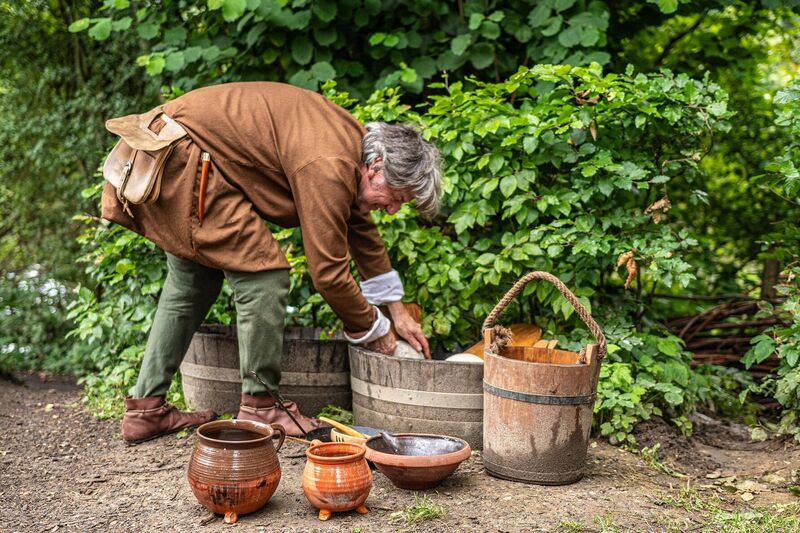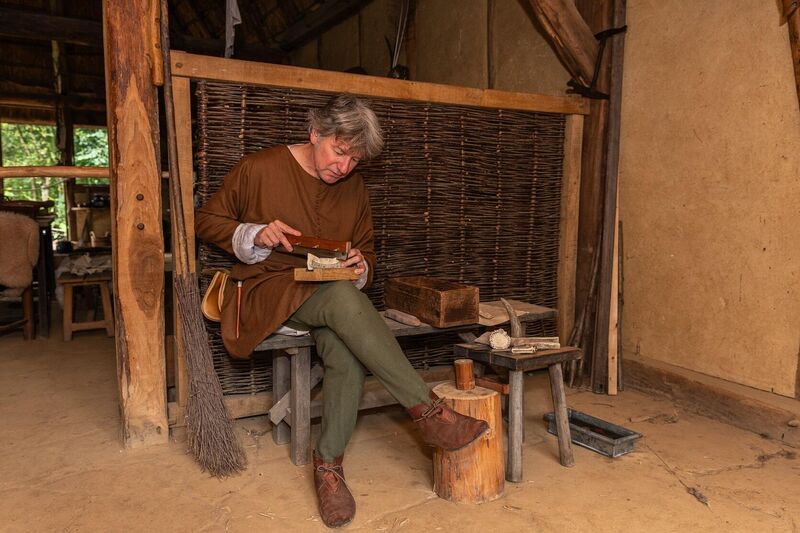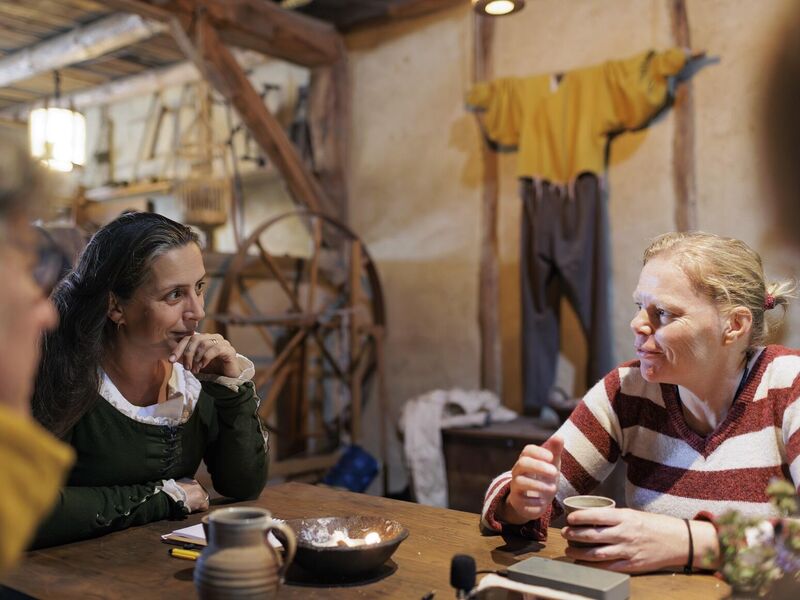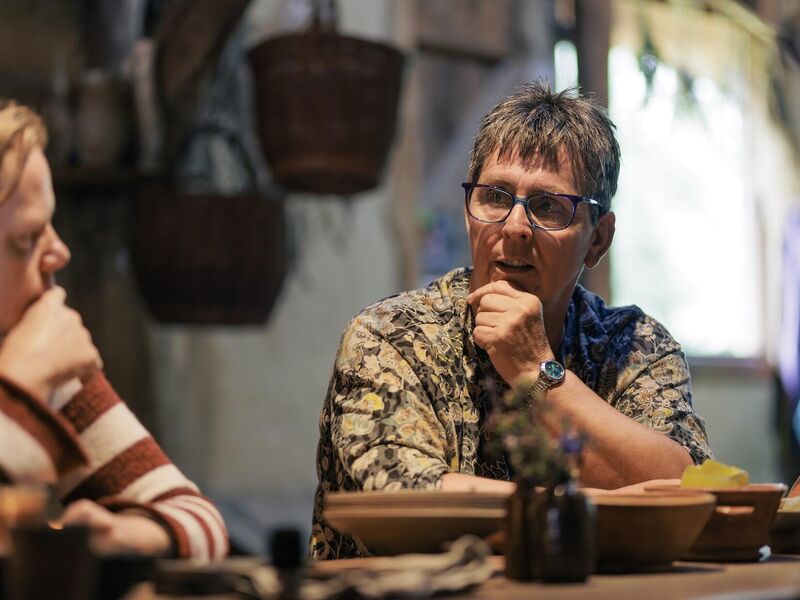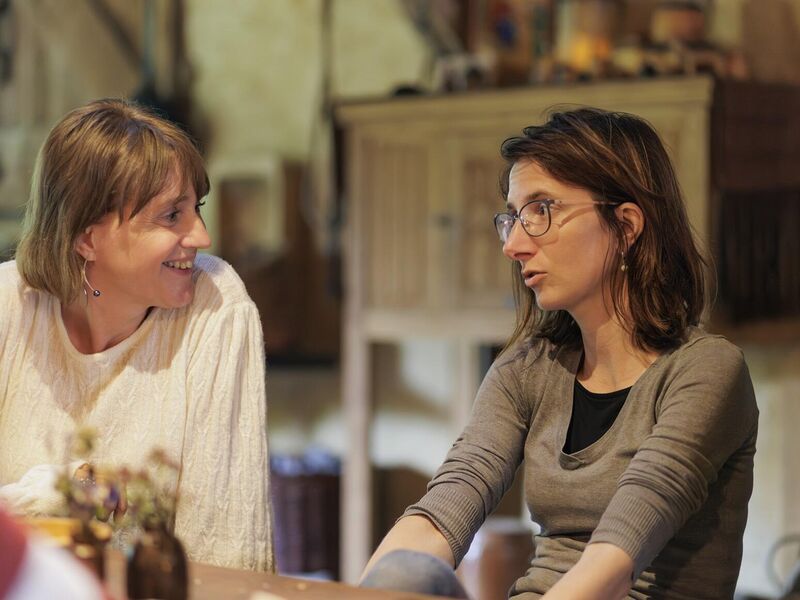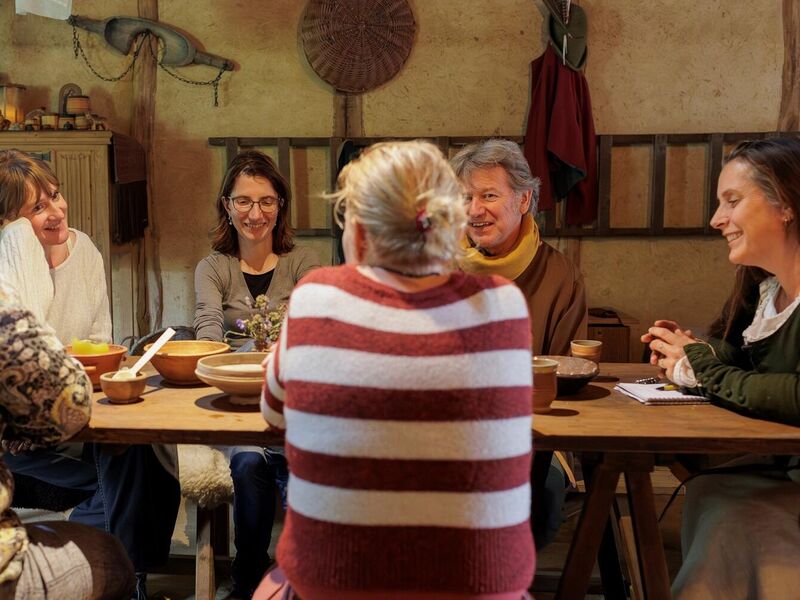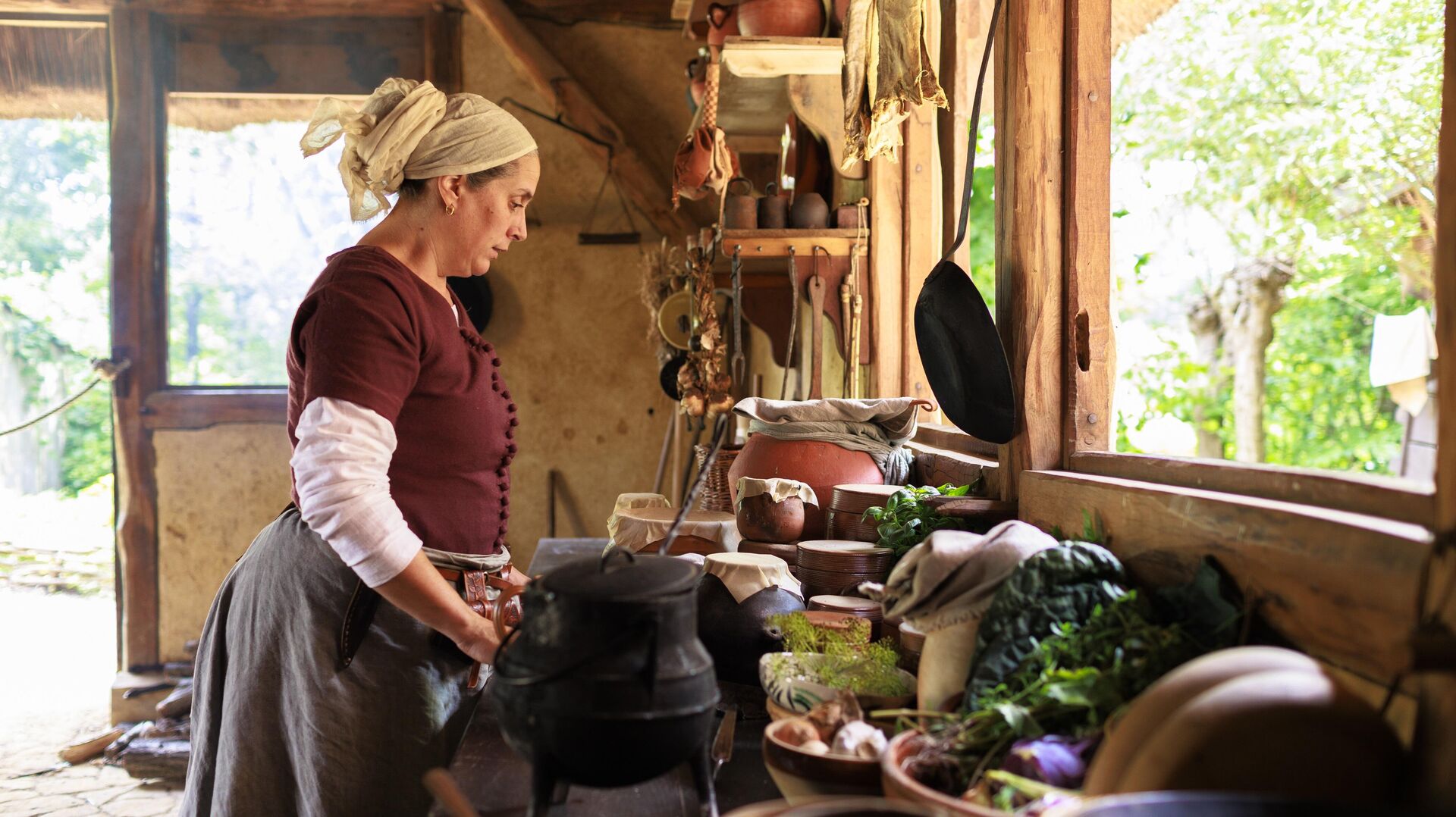
Stories about a medieval life
On this page, you can read the diary of Yvonne Lammers, who is currently residing in the medieval artisans’ house at the preHistorisch Dorp for two months in the summer of 2023. Starting from the idea to live in a medieval house, up to the invitation of experts and artisans and the daily goings-on in the house: it’s all right here in chronological order for you to read. So the most recent additions to the page are at the bottom. You can find more information about the project on this page.
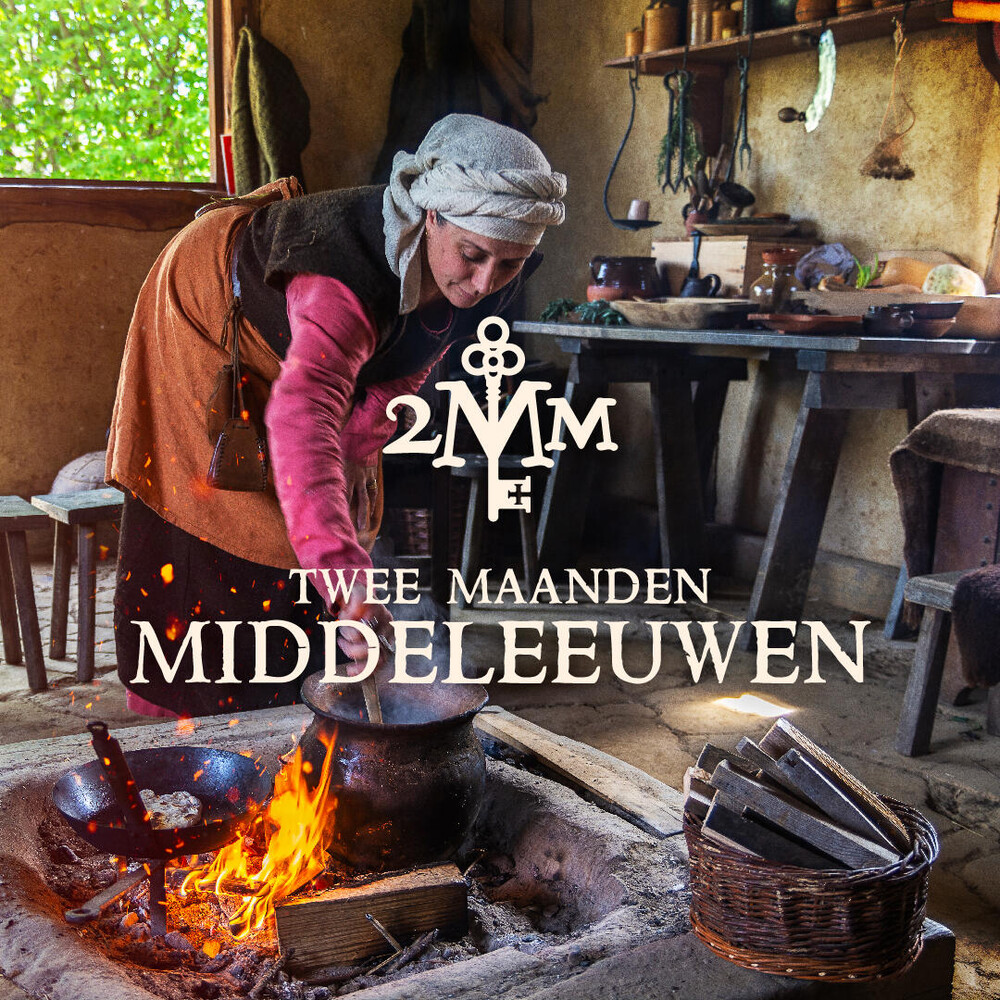
Let me introduce myself
My name is Yvonne Lammers. I’m currently the museum manager of the preHistorisch Dorp and in this capacity I’m responsible for the work in the field and for the event programming. I’ve studied theoretical archaeology as well as prehistory and protohistory and I have a doctorate in experimental archaeology. All in all, I have over 30 years of experience with living history, with an emphasis on education about prehistoric, Roman, and early medieval times. I’m a relative newbie in the field of the late Middle Ages, but this only makes this period even more interesting to discover!
Spring of 2022
I have an itch. Now the kids are finding their own way, the museum is running smoothly and life is going on as usual, I’m looking forward to some adventure. Fieldwork? A large trip? But how shall I go about this? I won’t, and can’t, leave the museum smack in the middle of the summer season. I look back on a recording for the Dutch television channel NPO1, in which Laura Kooistra, Joyce van Dijk and I are sitting by a fire, cooking and exchanging experiences and knowledge about food consumption in the Iron Age. In my previous life at the university and at my company Echo Information Design, I’ve built up quite a network centred on research. Ever since my youth, I’ve met many an artisan and living history experts thanks to my leisure activities in this field. I’ve renewed these ties during recent years working for the museum. Slowly, an idea is taking form in my head. I will go on an adventure in our own museum to unite both worlds!
Nearly 30 years have passed since Anneke Boonstra, our founder, re-enacted the Iron Age with a group of enthusiasts for the duration of two moons. It should be similar to that, but with a modern twist. I don’t want to put myself to the test – having a backache, hating my headscarf, and being extremely looking forward to a warm shower after two months. I also want to brush my teeth, after all, I’m hoping to live a longer life than the average medieval woman. No, I mainly want to inspire people: our employees and volunteers, our visitors, and certainly also scientists and artisans. So it should be possible to follow the experiment at the museum all the time. The choice for the fourteenth century is based on several ideas: 1. It’s an interesting period about which we know relatively much, so we don’t have to guess about everything, 2. I’m very curious what our artisans’ house would look like if someone lived in it, and 3. Last, but certainly not least if anyone can come and have a look: I simply look best in fourteenth-century dresses 😉
Summer of 2022
This is a nice idea, but how on earth am I going to get it approved? It goes without saying that I also have other work to do at the museum. The daily management of the field workers, the preparations for the museum expansion, the organization of events… I pitch the idea to Marjan Vossen, our marketeer. She thinks it would be a great summer project: nice for the visitors and an attractive topic for marketing materials. For me, behind the scenes, summer is a relatively quiet period and this means I will also be able to train people if I involve the time guides in the project.
I propose the idea to our volunteers – and they too are immediately enthusiastic! They especially like the idea of an exchange of knowledge. My itch grows – I’ll go for it!
Autumn of 2022
I hesitantly present the idea to our managing director Ward Rennen. I schedule this presentation at a marketing meeting, so Marjan can provide a positive note. Ward is instantly enthusiastic and says yes. I remember thinking “I don’t think he realizes what he’s agreeing to,” but I have my approval, I can get started!
Winter and Spring of 2022/2023
The tailor’s workshop has a foreboding: Yvonne has a plan that will take up much more time than she has available. They eagerly offer to make a new dress and undergarments. For the next couple of months, Iemkje Heier, Fiona Brandenburg, Juul Thijssen and Jip Seijkens will dedicate their loving attention to this. I’m touched and most grateful. What a gift! This winter, I’m often ill and January and February are hard to get through. It’s getting harder to find personnel and many weeks go by that I’m swayed by the issues of the day. It will certainly be a busy first half of the season: opening weekend, Easter, May holiday, Feast of the Ascension, Pentecost, Midsummer – these are all events that need to be organized. I sometimes lose heart about my two-months-scheme, but I get back on track thanks to the people at the tailor’s workshop, who are working hard on my clothes, and the participants of the textile group, who are making plans to put the loom in the spotlight: we ARE going through with ‘it’.
May 2023
The plan is only partly taking shape in my head, due to the huge amount of other work. I’m asking everyone for hypotheses I can test. Most people seem to be interested in human behaviour: “What will you do with your trash?”, “What will your daily routine look like?” But I prefer a different approach: “I think they used to mop the floor every day to prevent a buildup of dust. Would you like to do this for me for 8 weeks and take note of the circumstances at the beginning and at the end?” It seems to be more difficult than I had expected, but I trust the process. It will all fall into place as we go. I buy a particulate counter, a thermometer, and more and empty my house. I bring all fourteenth-century re-enactment materials and all of the salt-glaze pottery I took from France. I place an order at Atelier Jera and buy from Medieval Crafts. Fiona helps me find addresses and gather materials. I consult with Vera Bos, who has tons of experience in fourteenth-century re-enactment, to work out what I will and won’t commit to. I always pose the question: what does it add, what does the public see and what can be a test of a hypothesis?
June 2023
I invite specialists for discussion panels and publish the whole plan on social media. There’s a much greater response than I had expected: many want to follow us and are curious about the results. Naturally, not everyone realizes it’s not a living experiment like those that were conducted in the past. But especially those who are familiar with our field are very enthusiastic, which on the one hand suddenly makes me very nervous, but on the other hand, motivates me to think about how we can at least inform more people from a distance.
Last week of June 2023
What have I gotten myself into? There’s so much to do and that’s not counting my office work, which is mounting up as well… Fortunately, a lot of people are registering for the discussion panels. I’ve made arrangements with my overnight guests and they are looking forward to it as well. Yet I still dream about lists and oh, right, I also have a husband and two kids… My husband will be joining me in the fourteenth century frequently and my eldest son will keep mum posted about the modern world. My youngest son, Arthur, is lining up to be there as often as possible and do his artisan’s bit. So it will all work out fine. And it’s like they whisper in my ear: it’s okay to secretly go home on occasion. But that’s not what I want to do – it’s also about the adventure for myself.
First weekend: 30 June -2 July
We start off with an event. Was that my idea? I growl, moan, and sigh, because moving to another century, starting by cooking for 30 people AND running an event on the same weekend might be a bit much. So I allow myself some flexibility. Medieval people wouldn’t have been thrown in the deep end right off the bat and would have been allowed to ease into things. On Saturday evening I relish a stay-over visit from my entire family. Eva IJsveld, a dear friend who has been active in this field as long as I have (which is over 30 years, oof), joins us. It's incredibly cool to see the house come alive! This is how it’s supposed to be: stuff everywhere, a furnished kitchen, beds, and chests filled with textiles, a workshop in the front part of the house, and living facilities in the back.
It’s only when I crawl into bed on Sunday night and have the house to myself that I really realize it… the adventure has begun!
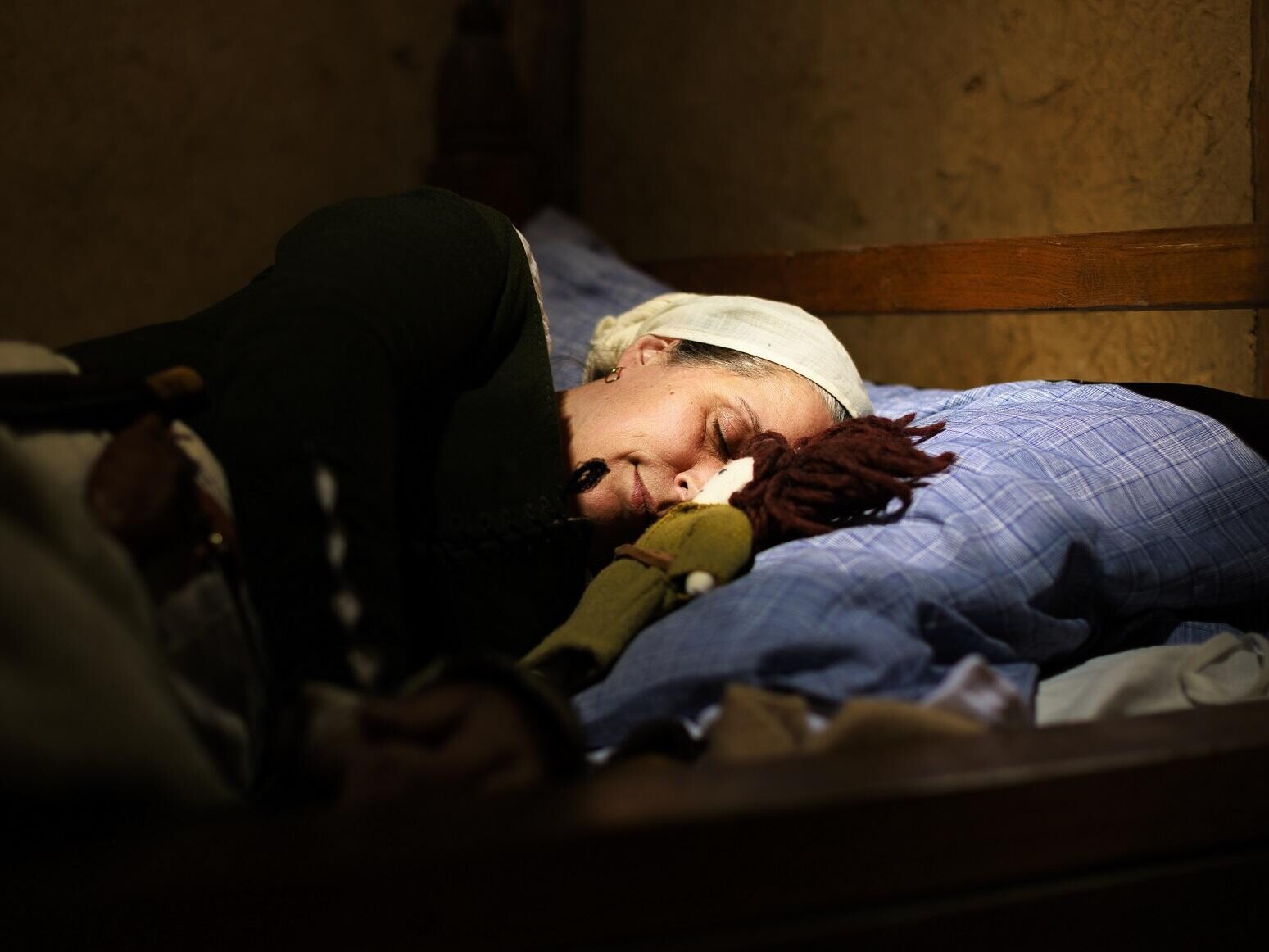
July 3rd: acclimatising to a new house
Even though it would be wonderful, I can’t run away from my obligations to the museum for 8 weeks. So on Monday, Ward and I have a ‘regular’ management meeting, albeit with me in medieval clothes. The rest of the day, I discover the weirdest things. For example: it’s not a good idea to place your drinking water next to your chopping block (duh). A fourteenth-century house will always feel a bit empty, because there are no bookshelves against the walls. And at the same time, it’s amazing how many things a person, even a medieval person, ‘needs’. Storage jars, sheets, towels, storage baskets, clothes, head scarfs, St. Brigitta caps, shelves, knives, containers, dishes, a kneading box, food. This is besides beds (one for me, one for my guests), chests, a chopping block, a great wheel, a loom and the historical dresser. But there’s a place for everything. The front part of the house will be open to the public, the back part will only be visible across the partition and through the windows. This way I’ll have some space to cook and live, while at the same time, I’ll be able to talk to everyone and show everything properly. I’ve brought many of the items here from my kitchen or bedroom, so it feels very familiar!
July 4th: animals
Every day I think: “This is the biggest challenge”. Before I started, I thought that visits from both colleagues and visitors and stay-over guests might be a bit overly sociable. That I might be yearning for some quiet or alone time. I’m sure that moment will come, but so far the flies, jackdaws, magpies, and sheep are competing for a top position on the irritation scale. The sheep start bleating as soon as they see me – that green dress means there’s food! And, inexperienced as I am, a sheep slips by me when I bring the hay this evening – to then sink her teeth into my kitchen garden in high feather! Even inside the house I’m not safe. If I leave anything unattended for a second, there’s a bird or a fly on it: butter, apples, milk, nothing is safe. I decide to put a lid, wax cloth, or piece of cloth on everything from now on. I dare you to try me, magpie.
July 5th: the floor...
Another one of our challenges and one of the questions we want to answer relates to the floor: how do you get this to be less dusty? Because everything in the house is covered in dust, and in the morning, I wake up with loam between my teeth. There are theories based on thin slice research on mopping with ammonia, thus binding the calcium in the loam and hardening the floor. Martijn (this weeks stay-over guest) from Het Noeste Leven is actually also a chemist and chuckles “Well, that’s only possible with pee and there’s just no way to get rid of that smell.” I wisely decide to test other hypotheses first. I can always test the ammonia theory in the last week. After me, the flood 😉 So today, my aid Florijn and I dedicate our attention to mopping the floor. Using a lot of water, so the loam top layer softens and the cracks in it are closed. Because I have a killing ache in my (always feeble) ankles and feet, I’m very glad for the help. The amount of dust even seems to diminish. We’re certainly going to be doing this more often!
July 6th: first Thursday discussion panel
The first Thursday discussion panel! I’ve been looking forward to this so much. I’m bursting with pride when the day’s guests start arriving: Silke Lange, an archaeological wood specialist from BIAX, Bram and Marijn from the Gilde van St Thomas (St Thomas guild) and turners as well as makers of stave bowls, Vincent van Deventer, a 14th-century re-enactor, Jeroen Flamman, from the direction of Vestigia, Leo Wolterbeek, a woodworking professional at Woud en Beek, Roos van Oosten, a university professor on the Middle Ages in Leiden, Martijn van Gerwen from Het Noeste Leven and a wood turner. They all gather up at the table with me and we have an interesting conversation about paint and linseed oil, axes and saws, ashes and alders, city and countryside, and professional and amateur turners. We agree to turn the discussion into a podcast later on. I’m especially pleased to see the enthusiasm – passionate ideas, for a sequel as well, fly across the table and everyone has learned something from the conversation.
For me personally, it’s also great that Jeroen is here: he’s the one who inspired my love for experimental archaeology 33 years ago during my first camp in Haps in Apeldoorn and thus put me on this track. Leo and I have also known each other for a very long time and it feels good that they both joined us and are well-disposed to the project.
July 7th: that floor again
Nanne is visiting and helps me mop the floor again. On the digital grapevine, many recommend I use wet sand and replace this on a weekly basis. I understand why farmers would do this, but how would someone in a medieval town acquire so much sand? Now, I can easily take it from the museum’s sandbox, but I don’t see where they would have found it 600 years ago. We continue to mop, because we are seeing a difference. We deliberately leave the front part of the house undone, so we can observe the difference.
In the evening, I delight in Martijn’s, Nanne’s, Rachne’s and Gwen’s company and our accomplishments at the table. At 9 PM, I can no longer keep my eyes open. I’m starting to get into a rhythm. I jump into my bed somewhere between 9 and 10 PM and get up at 5 AM to get to work. I start the day going ‘to church’– a nice euphemism for my office, where I can take care of my diary, the guests’ schedule, and my other administrative work. I will be spending less time on this now the holiday season has started, so I can dive deeper into the medieval experience.
July 8th: warm!
It’s sweltering hot. I decide to let the raw milk I got from my backdoor neighbour Age at the Genneper Hoeve rest for a day. I don’t really feel like churning it right now. Despite all my years of experience doing fieldwork in the tropics, I can’t seem to switch to a mode of slowing down and adjusting to the weather. My wool dress and linen underslip feel warm, but I know they’re also protecting me against the sun. Besides, having visitors and guests around means I can’t really walk around in just my linen undergarments. What would the neighbours say?! 😉 So I lay low as much as possible and work on my St. Brigitta cap, a small cap to wear underneath my beautiful head scarf. Since I only have to take care of myself today, I’m eating bread with fresh cheese containing herbs. There’s no need to make a fire today. However, I notice around noon that my stockfish and bacon, which are hanging over the fire pit, are covered in flies. The idea appals me and I wrap them in linen cloth.
The heat makes this a slow day at the museum, which is nice, because the first week felt pretty hectic. Getting settled, finding a rhythm, conducting more meetings than I had expected, getting my picture taken by several photographers, and the first discussion panel. The other relationship I now have with our visitors also poses a challenge. Normally, I talk to each visitor, tell them more about what I’m doing than actually doing stuff, and certainly never turn my back to them. I can’t keep that up now, because if I did I wouldn’t be able to get anything done. So I sought the middle-ground this week. I now greet everyone who enters the house and if they have any questions, I ask them to come to the window that’s closest to where I’m working. This way I can ‘walk and chew gum at the same time’. I’m currently still often explaining what I’m doing. Fortunately, there will be a signpost containing information about the project next week – that will save time.
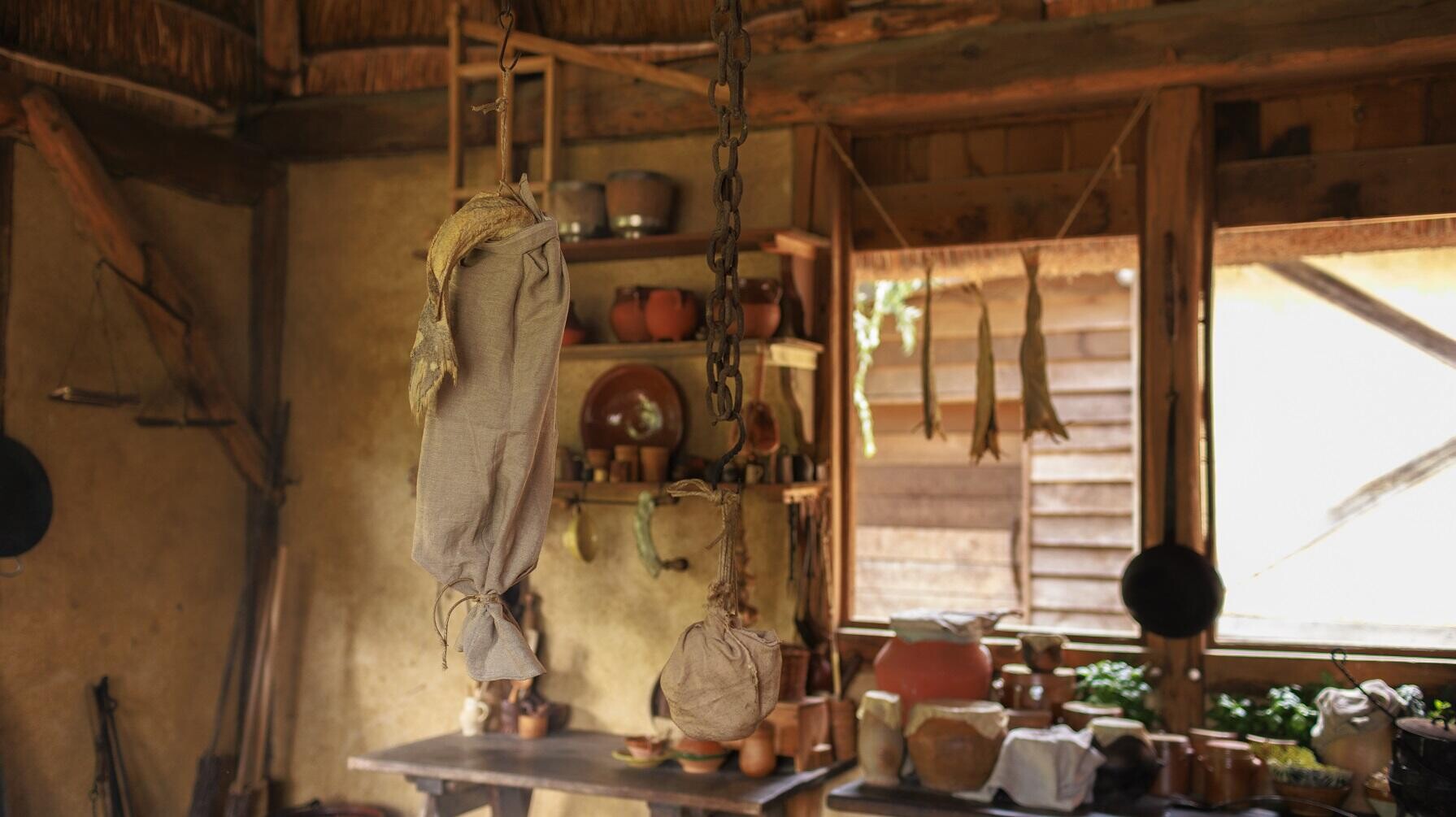
July 9th: warmer!
It’s looking to get even warmer today. It’s oppressively hot. You can really sense there’s a storm in the air. I decide to cook early, so I can close the roof hatch if it starts to rain. Because I’ve already had bread yesterday, I’m making a stew today, to save our bakers from burning the oven in this heat. A small cooking fire is better. I’m using my cauldron, so I don’t have to pay so much attention to my cooking pot. The earthenware pipkins are nice, but require a lot of attention: to make sure they don’t burst, they need to be heated evenly. When using them, it’s harder for me to cook and sew (for example) at the same time. Or, in this setting, to cook and talk to visitors.
I’m skimming the milk and making yoghurt by adding a spoon of old yoghurt to the raw milk. There’s no need to heat it with the current temperatures. I store the cream for tomorrow.
The flies annoy me. In the evening, when my husband Tino is visiting, I look for a solution online. Basil, vinegar, lavender and clove oil appear to be a good way to keep critters at a distance. A cup of vinegar on the table is easy enough to arrange. I also happen to have clove oil. It seems a bit expensive for this purpose, but oh well, I’m still using a couple of drops of it tonight. It’s helping. A bit.
I’ll ask our gardener to bring me some basil seeds tomorrow. Then I will put the planters on the windowsills. What would we do if the Romans had never set foot on our soil?
July 10th: visitors
Medieval life – cooking over a fire with what came out of the kitchen garden, sleeping in the house, fetching water – all this feels like the easiest part of this project. Combining it with office work and visitors is a lot tougher. My mind keeps switching from the future plans to expand the museum to my next vegetable stew. Life without a clock ensures that I am always late for meetings. Sorry colleagues – I’m doing my best! Knowing that this will improve at the end of this week (there will be no meetings for a few weeks and the rest I can do in the early hours) gives me peace of mind.
I must admit that I underestimated that “glass house” effect – it’s hard to decide when I can and when I can’t speak to people as I need to keep going if I want to achieve something. Chatting with people hanging in my window is easy while chopping vegetables for dinner. It’s a lot harder while making fire, fetching water, mopping, hanging up the laundry, kneading bread, or churning. I also notice that there are a lot of repetitive questions. “Why would you want to do this?” and “Where do you go to the toilet?” are the top scorers. I secretly started to tally that last one. I also set up our medieval toilet as a composting toilet. End of discussion – I can simply point them towards my daily production. In my mind, I give a grateful and sly nod to the sheep for the filling of the toilet, every time I place a tally mark.
July 11th: kitchen garden
Today Arno and Maaike are coming over to do the kitchen garden. That’s great as I have quite a few meetings today. The beans are ready. We will pick the last ones to dry them. Various wild herbs are harvested so there is room again for new growth. We even save the nettles for the soup. The kitchen garden is small, but it provides a lot. Arno has a much larger garden at home and as I have so many visitors, he supplements mine every week from his harvest. Currently, that’s mostly red beets. I gratefully accept his gifts. It feels great to be able to use so much of my own produce.
This evening Jip (this week’s guest) and her sisters Robin and Orion will be staying the night. It was a busy day, but I enjoyed seeing how the girls found their place in the house and adapted to medieval life. Their entire family are volunteers with us, and they have a lot of interest and attention in crafts. Clothing and gear were eagerly collected, and they worked to the last minute on one of the dresses. Just like mine, their dresses were made with fabrics from Classic Fabrics which are naturally dyed and of the highest quality. They look amazing. With bowls from Het Noeste Leven and knives from Black Oak Forge, the artisans who are connected to the museum are well represented, which makes me very happy 😊. I’m looking forward to spending the rest of the week with Jip. Unfortunately, the other two need to go to school.
July 12th: dairy
Today, I will be joined by Pimmie Schoorl, her daughters Vlinder and Finna, Anton Reurink, and Ella van der Most. For the rest of the week, they will be spinning and weaving at the house. Just like last week, group supervisor Kamiel will be so nice to fire up the oven for me on baking day. Having a baker who fires is not only medieval, but also very practical as the oven isn’t close to the house. The sourdough is working well although I can’t fully guarantee that it’s vegan – it seems to be very popular with the fruit flies. The loafs have risen reasonably well. I churn the now sour cream and get a very modest amount of butter. Earlier this week I had put the cream in the churn while chatting with a visitor, having forgotten to allow the churn to soak in water first. The cream gleefully flowed right out of the bottom. I could just save a bit. But I don’t care. I have my first butter made with raw milk that I skimmed myself and I’m proud. Not that the butter tasted good. The enormous heat caused it to taste rancid but not even that can spoil my joy.
In the meantime, I have made yoghurt twice. That went well too. For me it’s great to do things that I normally do at home in a clean environment, with thermometers, an easy-to-control gas stove, and a clock, but now by feeling in a medieval environment. I have no clue how long the bread or pies are in the oven, and the temperature of the milk to make yoghurt I test on my wrist. True archaeological experiments these are not, but that’s not really possible. Gathering data in this domain doesn’t say much, as the environment changes so much which has a major impact on the results. So I consider my activities as ‘experiential experiments’, experiences that expand your frame of reference as an archaeologist instead of seeking proof.
Jip and I decided to mop tomorrow. Cooking for nine guests, churning, and baking bread and two pies is a time-consuming chore. When mother Nancy comes to fetch Robin and Orion, we enjoy the pie… an 18th-century recipe with fresh apples, so we are cheating a bit, but it was delicious!
July 13th: Thursday discussion about textiles
The second discussion afternoon has arrived. I observe the group and have a sense of pride seeing who is sitting at the table. As we have many in-house experts, it feels like a home game. Anton Reurink is an authority in Leids Laken (Leiden cloth: a typically Dutch, very dense, woollen material), weaving, and spinning. Ella van der Most is a very experienced weaver. Pimmie Schoorl has been spinning her entire life and gives lessons online all over the world. Jip Seijkens is a very promising student at the Meesteropleiding Coupeur (Master Tailor program) in Amsterdam. All have been volunteers at the museum for years. It was Toon and Pimmie whom I performed the Oldest Dress of The Netherlands project with. Iemkje Heier from the Ghemertse Luyden has run our tailor’s workshop for years and has brought the quality of our clothing to a higher level. And she is also a volunteer. From ‘outside’ we have Iris Verhoeven (Historisch Weefatelier Verhoeven) and Veerle van Kersen (PhD at KU Leuven and re-enactor). They bring new questions and insights.
Very quickly we are discussing fibre lengths, spinning angles, warp starch, and the durability of fibres. “Fustian”( thick, hard-wearing twilled cloth with a short nap), “tierentijn” (a historical fabric made from linen and wool), “Leiden cloth”, and linen appear on the table and the English, Flemish, and Dutch terminologies are compared. Textile research is a scientific niche in countries like The Netherlands and Belgium – if only due to the limited number of finds. We finish with the realization that the inspiration regarding textiles will need to come from a larger context and that there is still a lot of (fun!) work left to do!
July 14th: firing the oven
Time guide Frankie comes to help. He would like to fire the oven for me, so Jip and I decide to make bread and pie again. Our oven is the oven of the Noble Homestead, the museum’s early medieval farm. It’s a relatively small oven. For Frank it’s the first time he fires the oven. In two hours, the oven is piping hot. Surrounded by a few visitors we empty it, mop it with the “sloerie” (a mop on a stick; sloerie is a Dutch slang word for a sleezy woman nowadays), and place the bread. As both of us are not yet (well) acquainted with this oven, it ends up being a tad too hot. Fortunately, by removing the door and moving the bread around we can limit the damage. After the bread, we pop in Jip and Finna’s pie. This one comes out beautifully once again!
July 15th & 16th: the St. Thomas guild
This weekend, next to the textile volunteers, the St. Thomas Guild will pay us a visit as well. Three couples who demonstrate crafts from the 14th and 15th centuries. Bram and Merijn, who were at last week’s discussion afternoon, dive into making “duigenbakjes” (shallow-stave bowls). The ladies embroider and cook. The guild and the textile group surround the house, shielding me, and answering many of the questions regarding the project. This is appreciated as I can now cook some very tasty meals for my guests!
July 17th & 18th: lots of children visiting
On Sunday evening my husband Tino arrives. So nice to catch up. Early Monday morning he departs again. There is work to be done at home and I need to get busy as well. These are busy days at the museum and once again I must speak to guests on my own. Scouting troops, daycare – the children have a lot of questions. The reactions are very different: some kids would love to join me, others would never in a million years! This goes for the adults as well! I cook a few simple meals and make some alterations to my dress. It’s just too large and so doesn’t fit well. Jip shows up for another two days and offers to help me. That’s great!
Tuesday afternoon, volunteers Maartje and Niels have a talk with beer historian Leendert Aalbers. Unfortunately, he’s not available for the discussion afternoons, but he became so enthusiastic about the plans to brew beer that he came especially to discuss this. I record the conversation and decide to see later if I can make a podcast out of it. Leendert also has quite some knowledge on how to make mead. And as I have some plans to make some myself, I am waiting with great anticipation to receive the medieval recipes he promised to send me.
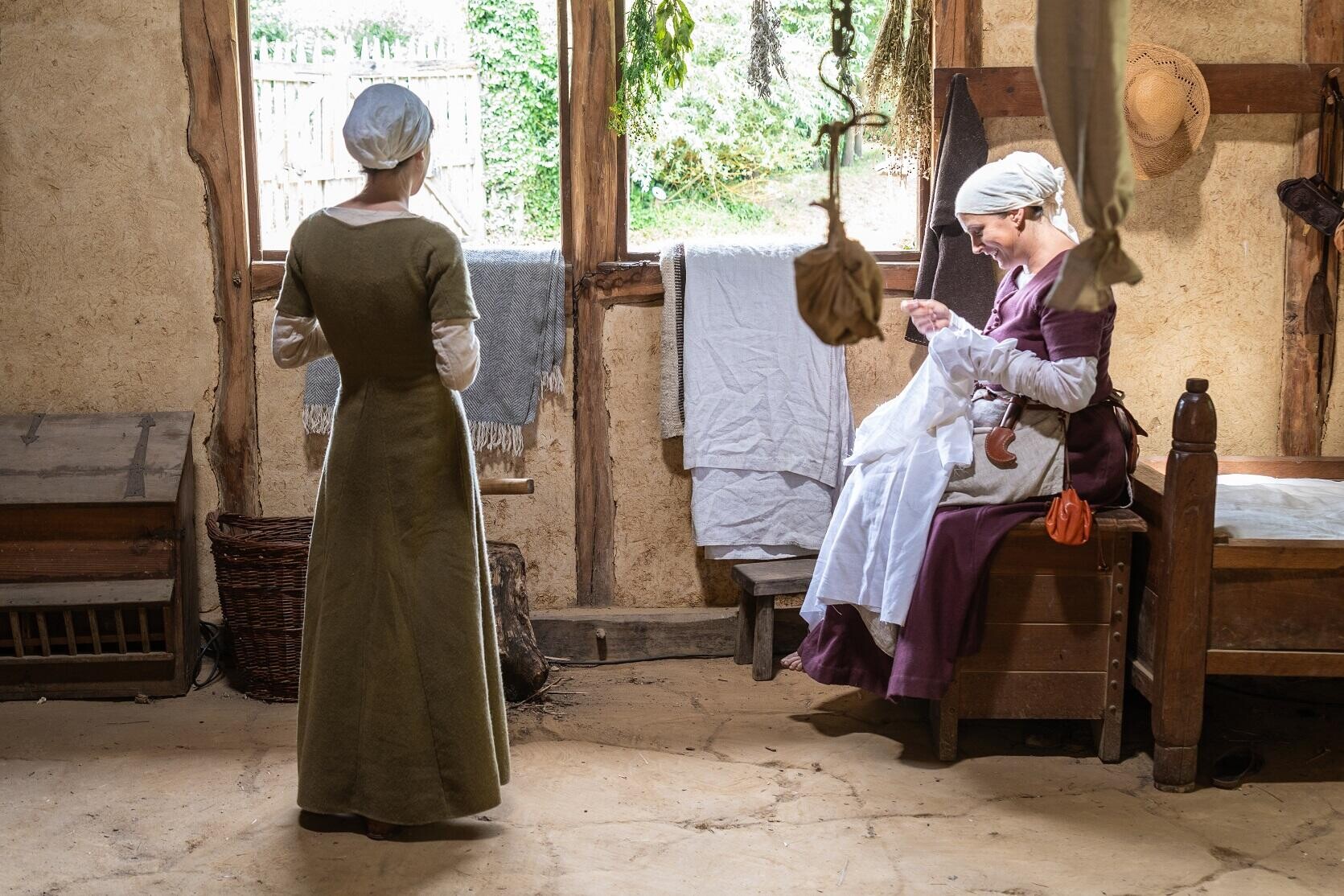
July 19th: cheese
Sacha Husken from Toen Ter Tafel arrives on Wednesday and gets to work full of vigour. We make plans for the next couple of days together. We will make soft and hard cheese today, roast a rabbit on the spit and cook a neck of lamb in a broth. We will use the neck of lamb and part of the rabbit in a pie tomorrow.
We also go ahead and soak the clipfish for Friday. Clipfish is a salted and dried fish that has to soak for at least 36 hours to become softer and less salty.
We get 6 litres (about 10 pints) of milk from farmer Age, in the wooden bucket with a lid. Since this milk is in the milk tap, it’s cold and needs to be heated before we use it. We do so by feel, in a large cream dish, repeatedly filling a stoneware can with warm water and moving it around in the milk, until the milk reaches the right temperature. Sacha adds artificial rennet, so we can make both soft and hard cheese. Optimally, we would need a calf’s abomasum to make hard cheese, but this alternative will have to do for now. After half an hour, the milk has curdled and we cut the curd into small pieces. We make soft cheese of about half of these. We ladle them out of the dish, add dried herbes de Provence from my garden at home and wrap the curd in a wet cloth in the earthenware cheese moulds. We put small jars in them to press the whey out of the cheese.
To make hard cheese, we need to reheat the curd. We do so by adding warm water and gently stirring the mass. When the curd has thickened, we pour everything through an earthenware strainer and add some salt to the mass that’s left in the strainer. We put this in the linen-covered cheese mould and put some weight on it with the cheese press, using the cast-iron weights I brought. After half an hour, I add more weight. Since the mould is too large for the amount of curd, we once again use a jar to apply pressure – the official follower (lid) can’t reach low enough due to its convex shape. I’m so glad I went hunting for stoneware during a large part of my last holiday in France and now have jars in all sizes!
I suddenly realise we can also make ricotta from the whey. We heat it up to about 70 degrees Celsius and then add a dash of vinegar. When we heat the whey a little more, the last bit of fat clumps together and this becomes a kind of cheese that squeaks between your teeth. It’s not much, but it’s fun to see we can use the last bit of milk fat this way. Once the whey is cooled, I pour it near the plants in the kitchen garden. In my mind, I promise the pigs they’ll get it next time – apparently, they’re crazy about it.
In the meanwhile, Sacha has attached the skinned rabbit to the spit and is now roasting it over the fire. We cook the princess beans in the broth of the - now well done - neck of lamb. Concurrently, I make a simple honey-mustard sauce, boiling honey, mustard and some broth. I’ve brined the rest of the harvested beans. The brine is made by adding nine cups of water to one cup of salt and seasoning this with laurel, juniper berries and a clove. Sacha makes me blush by informing me these specific beans are originally from South America and are most certainly not medieval. I mumble a bit that it’s strange the growth habit looks so much like regular peas and field peas, but of course the ‘flat crystal ball’ we consult tells us she’s right. Oh well, a vegetable is a vegetable and I just hope brining them will lengthen their lifespan. We’re out of fresh beans now, so I can leave them out of the menu with a clean conscience for the next couple of weeks.
When we’ve finished doing the dishes, for which we heat some water, we eat at the table by the light of an oil lamp, relishing every bite – and every sip of the white wine brought from Rhineland. What a feast! Not really a typical artisan’s meal, but perhaps the lord of Eindhoven castle has rewarded us richly for the beautiful fabrics we sent him 😉
July 20th: discussion Thursday about food
On the second day of her visit, Sacha makes a sweet and savoury pie. We fire the oven and Sacha combines the remains of the rabbit and the meat of the neck of lamb with yesterday’s fresh cheese, honey-soaked dates and pistachios. She makes a beautifully prepared pastry for the pie and decorates the pie using a lid with a face on it. According to the recipe, this pie is called a ‘Turk’s head’. Sacha colours the face using mixtures of beaten egg, spinach powder, and red sandalwood.
I take the cheese from the press, cut it to an even shape and wrap it in a cloth to dry. I will be turning and checking up on the cheese frequently during the next couple of weeks and, if necessary, rub it with salt to prevent mould formation. At home I would keep it in the refrigerator, so I’m curious to see what will happen now. I actually miss that refrigerator most of all. Gardening volunteer Rianne helps me get 6 more litres (about 10 pints) of milk from Age. Since the wooden bucket with lid is pretty heavy, this is about the maximum volume I can get per trip. Back at the house, I pour the milk into a large cream dish, cover it and store it somewhere where it will be left untouched, further away from the fire.
In the afternoon, Theo de Jong (Archeologie Eindhoven en Helmond), Joyce van Dijk (Archeoplan Eco) and Wouter van der Meer (BIAX) arrive for our weekly experts’ discussion. We enjoy the tasty pie while conducting a wonderful conversation about animal and plant remains, the differences between the food of rich and common people, recipes and their value to the project, given that they have mostly been written for the meals of the rich, and about how representative cesspit research is for the reconstruction of meals. We agree that the limited use of the sieving method causes a hiatus in the spectrum: small birds and fish are overlooked, as well as many seeds and pits. Still, a lot of good research is being conducted, like the promising research into Huis Ter Kleef (castle in Haarlem, Netherlands). By the end of the discussion, I make an incredibly stupid mistake – I forget to save the recording. Apparently, my brain has become so medieval, that I’ve forgotten how to use modern technology. For a moment, my eyes tear up. I check and check, but the recording is gone! I so wanted to share this discussion with everyone! But the conversation was pleasant and Sacha and I decide to talk about what we’ve learned over dinner and to record that, so there will be something to share after all. In the meanwhile, the conversation is also still going on, which I record as well, so I may be able to use that in the podcast too. This will take some editing, but I’ll find the time somewhere.
For what it’s worth, Wouter, Joyce and Theo have learned and shared a lot and will be sharing that with their base. I show Wouter where I deposit my waste. He will come back later to excavate the pit. I expect it won’t be much – I feed everything that has no meat in it to the pigs. But I did bury the rabbit carcass in the pit, so it will definitely be interesting to see what’s left of that after the following weeks.
In the evening, Sacha and I eat the remains of the pie and some cabbage cooked in the broth. We go over the discussion, talk some more about the amount of honey and wax a female artisan would have had at her disposal and go to bed feeling good despite the botched recording.
July 21st: butter
After my morning routine, I run into Sacha. I can see right away that she’s not feeling well: migraine. Apparently, it’s going around: the photographer and another employee also call in sick. Unfortunately for Sacha, it means she will have to leave the Middle Ages prematurely. I remain with the recipes we were supposed to cook and she promises to come back before the end of the project.
It’s a disappointment and I also notice I’m not feeling ship shape myself. I have a cold, am coughing and am dreadfully tired. There are a lot of interested visitors, but when I’m alone here, it’s hard to find a balance between working and educating. I struggle to get through the day, but at least I do get some things done. I skim the fat off yesterday’s milk, which has surfaced beautifully in the cream dish and is floating on top of the milk forming a thick top layer (like the skin on boiled porridge). I obtain about half a litre (a bit less than 1 pint) of cream from the six litres (about ten pints) of milk. I get a lot of questions while I’m churning in the (already soaked) churn. I realise once again how useful it is to share this with the public: many don’t have a clue how to make butter, cheese and yoghurt, even though they do eat it every day.
I churn and churn, but it’s not working. It’s like all of the fat globules are sticking to the edges of the churn like whipped cream, resulting in too little movement for the substance to clot and form butter. Willy, the volunteer who has made the cheese press, pays me a visit and asks why I don’t churn from the milk. I decide to add a litre (just under 2 pints) of milk. Hanneke has just finished her office duties and joins me as a fourteenth-century artisan for an hour or so. She takes on the churn and the visitors asking questions and I gratefully retreat to my cocoon. The butter quickly does what it’s supposed to do and the fat clots beautifully, creating about 100 grams (about 3.5 ounces) of butter. And, once again, a lot of fatty dishes. But I’m content. I’ll be repeating this process several times during the next few weeks and this experience will make that a lot easier.
Since I can barely keep my eyes open around 5 PM and I still need to take care of the laundry, dishes and some managerial duties tonight, I postpone the fish until tomorrow. I do take it outside, though, because I’m getting queasy after smelling a combination of fish and warm milk, butter and broth for a whole day. Let's hope the birds don’t come up with a trick to get under that cloth covering the bowl.
In bed at night, I can’t seem to fall asleep. I’m thinking about my best friends. Two of them are on holiday together visiting a fjord. In my tired state, I briefly dream about joining them and endlessly reading books. At the same time, another friend is establishing her own sheep farm in France. It’s funny how much our daily activities correspond now. This makes both the physical and emotional distance seem much smaller and gives me extra energy to simply keep going. With a melancholic sigh about life and life’s paths intertwining and separating again, I turn to my other side and fall asleep.
July 22nd: clipfish
The fish Sacha and I have put on water now really needs to be processed. I rinse it and remove the skin and bones. That’s not as easy as I’d hoped and I’m left with a relatively small bit of fillet. I use the rest to make fish soup. I boil the fillet in water. Because I forget it’s on the fire, most of the water evaporates before I realise what’s happening. I quickly cut some garlic and onion. I bake these together with the fish and add some bruised long pepper and oil. This results in a spread that would be a wonderful addition to a Surinamese roll of bakkeljauw (clipfish). I know this is not exactly authentic (Christianne Muusers’ medieval recipe calls for apples, raisins and peas) but it is very tasty. And I’m freed of another less-appealing odour 😉
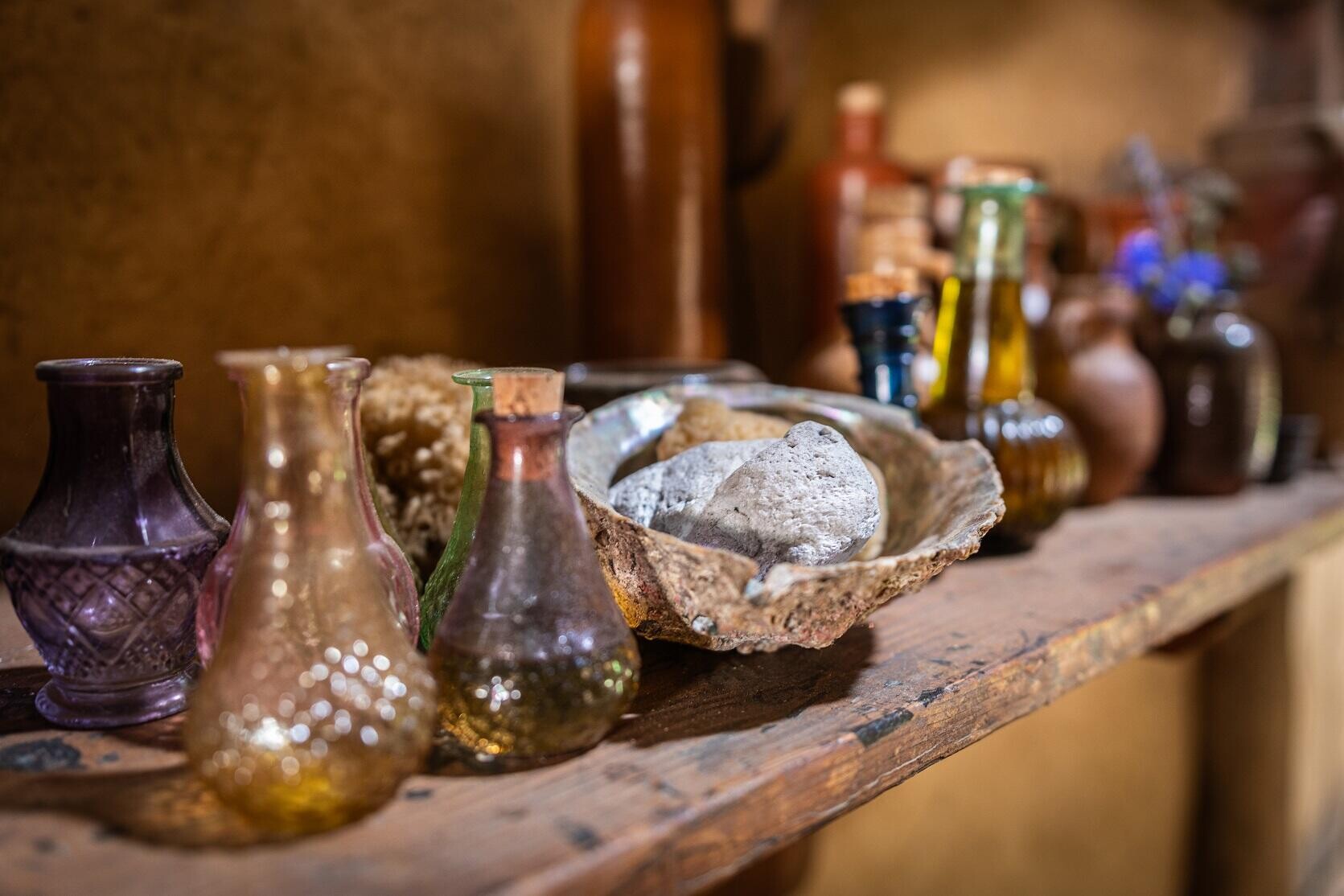
July 23rd: splashing about and Sunday rest
It’s Sunday. It occurs to me that it wouldn’t be a bad idea to have a day of rest. I use my office time to have a good wash before the museum’s employees and visitors arrive. I usually just wash myself superficially with a cloth at the tub (like my mother once taught me at a campsite), but it would be great to feel some water running through my hair for a change. I heat up a pot of water over the fire, drag a tub inside and get yet another bucket of water. Especially washing my hair is something else. I try to prevent too much water from spilling on the floor, getting dirtier from the floor than clean from bathing, or dropping my linen towel on the floor. None of it is very relaxing, but in the end, I’m cleaner than when I got started. Now, all I have to do is get rid of the tub of dirty water. Once that’s done, I’m glad I can sit down by the window and sew all day.
July 24th: rain! And a leaky hatch
On Sunday evening, it starts to rain harder and harder. I close the roof hatch because rain is coming in, but it doesn’t really help. There’s a large gap on the top side and unfortunately, the wind is blowing in the wrong direction, causing a lot of rain to blow inside. Four buckets mostly keep the floor dry. I don’t see how much it has rained until the next morning. By then, my washing up bowls are full and there are lots of puddles throughout the museum. Fortunately, they disappear quickly and I have a wonderful day with lots of visitors and a visit from the local public broadcast corporation Studio 040, making a recording.
July 25th: press!
The attention from the local paper Eindhovens Dagblad and Studio 040 set off a snowball effect. The project is mentioned in the morning news broadcast of national public broadcast corporation NPO Radio 2, I get interviewed by local station Omroep Brabant, by ‘Langs de lijn en omstreken’ (a program about sports and news) from national public broadcast corporation NPO Radio 1 and I have an appointment for ‘Jan Willem start op’ (a morning broadcast by national public broadcast corporation NPO Radio 2). I’m glad these conversations turn out to be very pleasant, without an undertone, the museum is mentioned clearly, and I get to tell something about our discussion Thursdays and the people involved.
In between affairs, there’s a surprise visit by my parents. Both have dedicated their lives to education and before I know it, my mother is inspiring children at the window. It feels good to have them here – both have gifted me with the love of education and schooling. My mother also taught me many skills that have led me onto this path: sewing, spinning, weaving, and baking bread. We’ve always done a lot together and it’s nice to show them what I’m doing.
July 26th: Theo’s coming
This week Theo’s coming to stay over. He works as a city archaeologist in Helmond and specializes in animal remains. Besides this, he’s also very creative with bone and antlers and he works leather. Even though Theo doesn’t normally join in re-enactments, we dress him up in a 14th-century outfit. After some searching for a role, he’s in the front part of the house as ‘my husband’ in no time, as if it had been his workshop for years already. He makes a comb out of antlers and saws even teeth using a double saw. The visitors are fascinated, as am I, to be honest.
Theo being here, chatting with many visitors, leaves me some more time for other things. We go out to get six litres (about ten pints) of milk and I make a small soft cheese and a hard cheese. It takes me a long time to heat up the milk. ‘Room temperature’ is obviously lower than last time. Even though the curd doesn’t look quite as I’d like, I put it in the press – we’ll see!
I finish just in time to be able to conduct a tour of the museum. One of the employees is home sick and there’s no other remedy than for me to help out in the field. Visitors first. After the tour, I cook a vegetable stew and we gather at the table with a content sigh. Another day ends.
July 27th: Discussion Thursday – house, garden and animals
For this week’s discussion, I’m joined by Anja van Zalinge (city archaeologist in Haarlem), Mieke de Leeuw (assistant archaeologist in Haarlem), Roos van Oosten (university professor in the field of the Middle Ages, Leiden University), Annemarieke Willemsen (curator Middle Ages, Rijksmuseum van Oudheden- Dutch National Museum of Antiquities) and Theo de Jong (city archaeologist in Helmond). I’ve really been looking forward to this because I have tons of questions and each of them brings a wealth of knowledge to the table!
It’s a fascinating conversation that substantially alters my idea of the Middle Ages. Being a specialist in prehistoric times with a romantic view of that society, I always pictured the late Middle Ages as a time of a monetary economy brimming with competition and individualism. I now have a more nuanced view. It appears to have been a society of collaboration, smartly dividing tasks, with people strongly depending on each other, which I previously thought was only true for prehistoric times.
I had envisioned huge differences between a green city like Eindhoven and a densely populated city like Haarlem, but it turns out they are more alike than I thought as well. People in Eindhoven had a kitchen garden next to the house, and Haarlem had allotments outside of its city walls where every family grew their own vegetables as well. And craftsmanship didn’t mean you never did anything else. In times of harvest, the craftsmen and women also worked the fields to help farmers bring in all the crops.
Between going to church and going to the market, collecting water and fuelwood, taking the children to school, and working in the distantly located allotment or fields, the city dweller’s world is quite a sizeable one. It takes up at least the entire city and the directly adjacent areas outside city boundaries. All in all, the late medieval society was a bit less individualistic than ours, with a lot of hard labour, but undoubtedly also a lot of time for social interaction with fun and gossip! More subjects come up and I’m glad I’ll also be able to listen to this week’s recording later on.
In the evening, Annemarieke stays the night in our early medieval noble homestead. Her typical directness really hits me: the building is too large and looks too much like a Viking hall. I need a moment to take it in, but of course, she’s right. When we built it, the house was enlarged so we can accommodate school classes and it hasn’t been decorated sufficiently to look like a lived-in building. I resolve to make improvements this winter. It turns into a good, animated conversation and while I tear myself from the 14th century, I get swept into the ever-elusive early Middle Ages. I soak up all new knowledge like a dried-up sponge. This fall, the Rijkmuseum van Oudheden (Dutch National Museum of Antiquities) will launch an exhibition about the year 1000 and after these pleasant conversations with Annemarieke, I hope to be one of its first visitors!
July 28th: busy days
Life is really happening to me today. The day starts off with the radio station Radio Veronica. Its reporter is at the gate at 6 AM. She’s clearly from a very different world, but she likes everything. She’s here very shortly, just for a brief interview, feeding the animals together and making fire. This means I have time to have breakfast with Theo and Annemarieke and to make an after-movie about yesterday with Marjan. We say goodbye to Annemarieke, and Hanneke and I go to the farmer once more for milk to make butter. Upon our return, Hanneke chops some kindling wood and a piece of her thumb. Without as much as a second thought, I run to get the modern first aid kit – the blood is oozing out! We’re glad she was using one of Henk’s axes because he’s one of our volunteers who forges razor-sharp axes. Fortunately, she starts to feel better within an hour or so. The wound stays dry and Hanneke is less wobbly in the legs. All ‘good pieces of advice’ raise this life-long scout’s blood pressure, which is a good thing today 😉 Now I can go ahead with my photo shoot with our photographer Duncan without worries.
It takes until after lunch to feel like I’m ‘living in the Middle Ages’ again. Sometimes, all modern interruptions are hard to deal with, but I know we would regret it if we didn’t record any of the whole happening. Besides this, I would also like to write a book afterwards and will be needing pictures for that too. The rest of the afternoon runs smoothly, but I’m already nodding off before closing time. Theo has one look at my tired face and decides to leave before dinner, for which I’m grateful. I have a sandwich and then jump right into bed. I really need to sleep! Fortunately, the house is nice and dark once the shutters are closed and I’m asleep like a baby in a nick of time.
July 29th: more rain!
Saturday turns out to be a rainy day. Cissy’s here to film. This is never annoying because she lets me do my work and is frequently calling out: ‘I’m not here!’ 😊 We have fun because she keeps telling me I can smile more when I’m working in concentration. When I look at the footage, I see I’ve forgotten to do so most of the time again. Unlike my angry facial expression suggests, I’m having a really good time this morning. I’ve slept long and well and I’m all over the process of skimming, churning and making fresh cheese from skimmed milk. Of course, it turns out this cheese has less of a ‘full’ flavour, but because I’ve seasoned it well with long pepper I think it’s very tasty anyway.
Today’s the first day it’s warmer inside than outside. By about 2 degrees. The flies have noticed this too and swarm in. I don’t let this discourage me anymore. I make sauerkraut from a small pointed cabbage, chopping the cabbage really small and kneading it in a large bowl while adding salt, caraway and juniper berries. I keep kneading it until the fluid comes out. Then I place the heap into a stoneware jar, press it firmly and pour a bit of water on it. I cover the jar with a wax cloth and a lid. I store it in sight, so I won’t forget to press it every day to keep the cabbage covered by liquid. I forgot to do so with the salted beans and then the top ones got mouldy. I removed those and the rest appears to be okay. I’ve put a small dish on top of those so they’ll stay covered in liquid. Somewhere in the back of my head, there’s a nagging thought about invisible mould filaments in jam and how you can’t remove mould like this, but I will put my trust in my nose and eyes over the course of the next few weeks.
In the meanwhile, it’s raining cats and dogs. I invite two families that are loitering outside my window to come inside – a small comfort for a very wet outing. The children enjoy the privilege of being able to touch everything and look at the interior up close. It’s now raining so hard that I have to close the roof hatch as well as some other hatches to keep my bed and my possessions dry. This makes an impression – suddenly the visitors realize I actually live in the house and am really concerned that I may have to sleep in a wet bed tonight. I realize once again that this project, but also my life-long love of history, seems incredibly strange to a lot of people. They just can’t believe we all really enjoy this.
Despite chatting and taking shelter, I get quite a bit done: I move the buttons on my purple dress, so Iemkje won’t look at my bodice with such disdain😉, attach another piece to my underslip and, in between rain showers, do the dishes with hot water. I am starting to long for something soapy, so I’ll have to do something about that soon.
I cook more soup because Bastiaan de Zwitser and his son Taran are visiting. They will be joining me for dinner with Gwen and Lola. I decide today is a holiday (there’s bound to be a holy person somewhere to honour) so we drink wine and I light some candles. This is the good life! I go to bed way too late and decide that tomorrow I can skip office work for once. Sundays are meant for sleeping in, right?
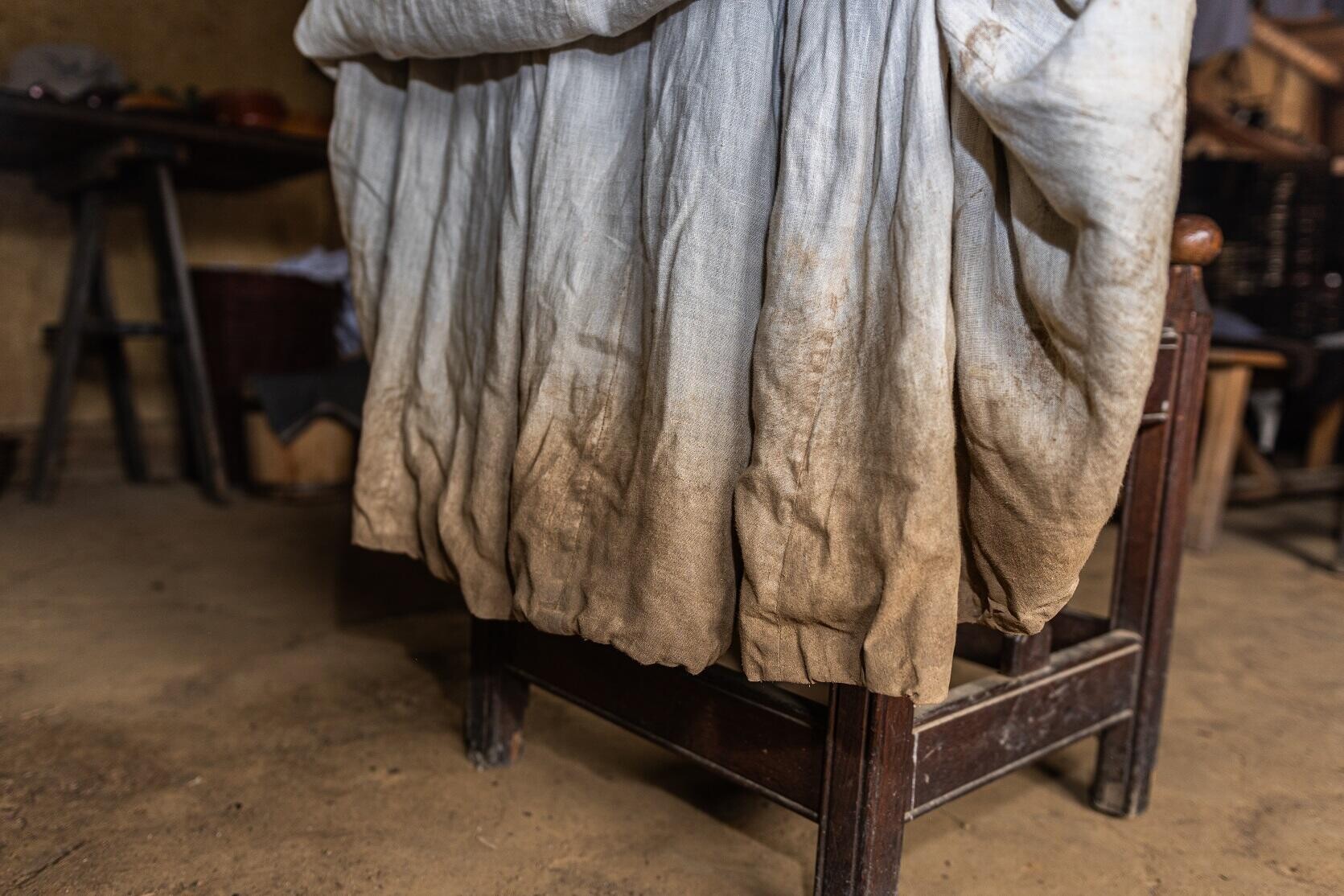
July 30th: mould and moisture
Now the humidity in the house has clearly risen, it seems like everything is becoming mouldy at once. I check the cheeses twice per day and remove small bleu patches by rubbing the crust with salt. The cabbages, which had kept for weeks until now, are suddenly starting to show brown patches. There’s mould on my sourdough bread (which I admittedly sort of forgot about) and everything feels damp. I’m a bit worried about drying the laundry. My new underslip is almost finished and I need it. It takes the laundry two whole days to dry every time and with all the mud and filth around and a dress with which I mop the entire village, I would like to at least have a clean underslip every day.
Fortunately, it’s Sunday – that day of the week that I allow myself to sew all day long. I really enjoy this. Seated on the chest at the foot end of my bed, beside the window where a visitor hangs out every once in a while. A lot of nice conversations arise at that window – about how relevant this project is for modern times, about world travel, problems with humidity, durability and being self-sufficient. It’s a real possibility that I’m learning more about our visitors, than about the Middle Ages these days!
August 1st: Lammas
Hebe Verhelst and Henri Cosemans will be staying over this week and will be making oilcloths and wax cloths. It so happens we were just talking about that last week. In historical re-enactment, they are used frequently to cover jars, but of course, they can’t be found archaeologically. Henri is working on dissertation research about waterproofing cloth and has found many recipes and mentions of oilcloth and wax cloth already – going all the way back to the 14th century! These are mostly based on linseed oil.
This week, he and Hebe will be running several experiments and testing various recipes. That’s pretty scary because it’s flammable, so I take the precaution of getting an additional fire blanket and extinguisher from the technical department. We place these next to the more decorative and medieval buckets of sand. In the evening, we eat together at the table. Hebe has been a time guide at the museum for years already and has specialized in vintage textiles and their restoration. She’s a very thorough researcher, which is always very nice to see and hear. I didn’t know Henri yet, but he too turns out to be very cool and know a lot. This will be another fun week!
Lying in bed, I remember today is Lammas – the celebration of the first fruits of harvest. Sometimes I’m a really crappy witch. Oh well. As a medieval woman, I’m far too busy to celebrate right now and I actually just had a party last Saturday. I’ll offer a small sacrifice tomorrow – I don’t think Mother Earth is a nitpicker … And besides – I’m living in a very clerical time right now, so I shouldn’t even be considering this!
Would you like to visit Yvonne?
The project ‘Two months in the Middle Ages’ has ended by now, but the preHistorisch Dorp is still open. The museum is open from April through October. Besides the medieval artisan's house, it houses many more building reconstructions from prehistoric times until the late Middle Ages. Check out our home page to see what's happening at the museum.
